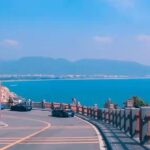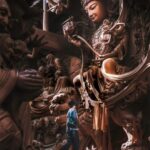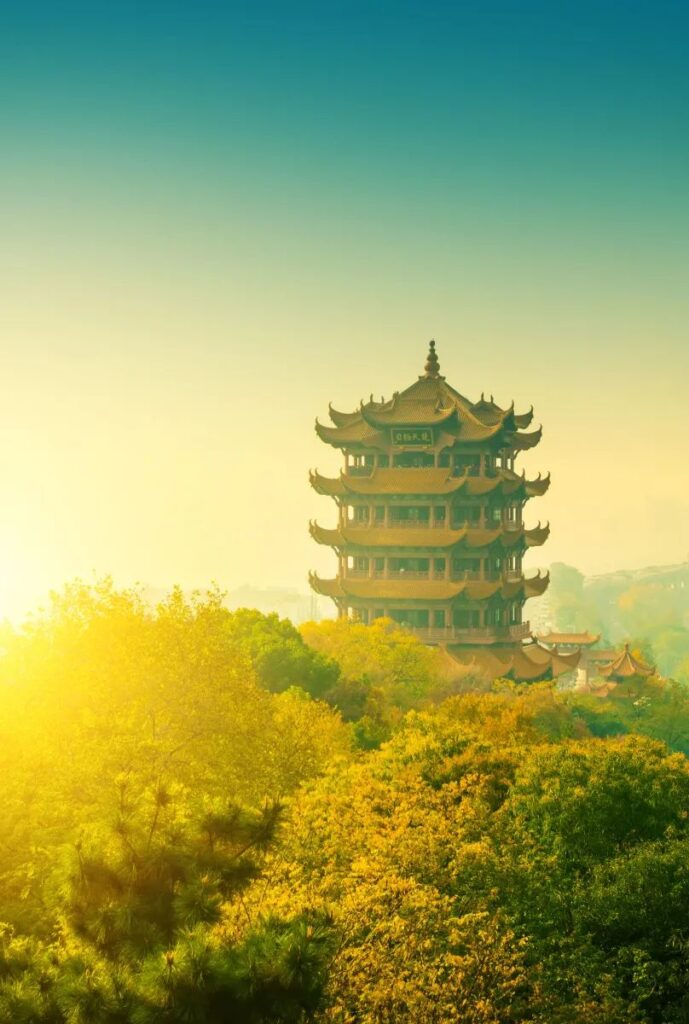
Wuhan, also known as the “River City,” is a metropolis rich in cultural heritage, where the classical and the modern coexist harmoniously.

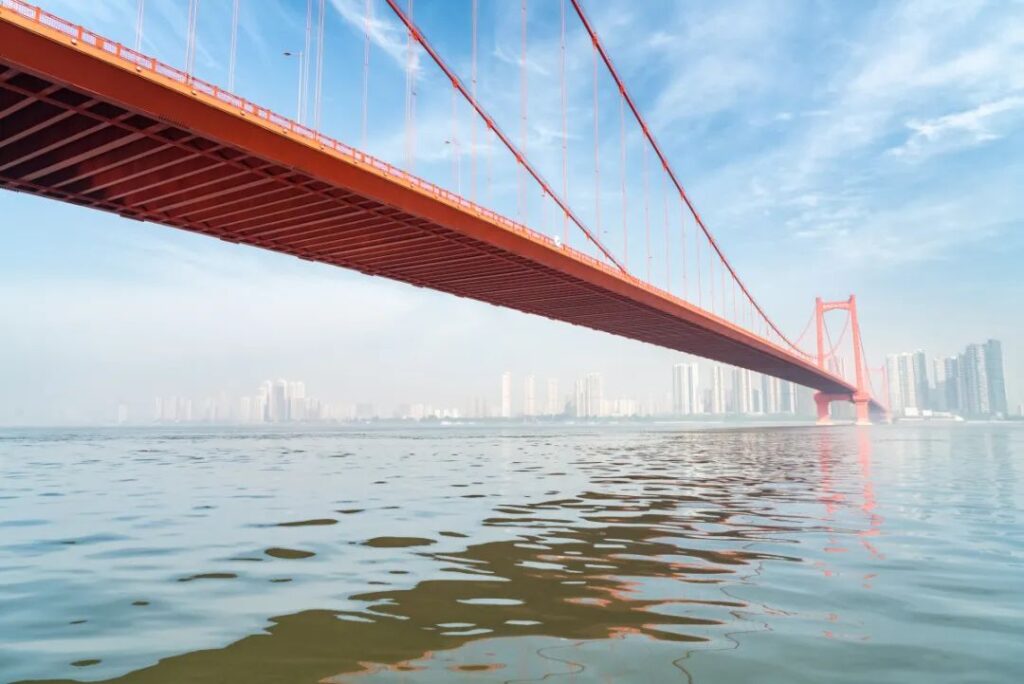
Introduction to Wuhan’s Main Tourist Attractions
Yellow Crane Tower

- One of the three famous towers south of the Yangtze River and a landmark of Wuhan.
- Ticket: 65 yuan and up
- Opening hours: 8:30-18:00
Gudetama Temple
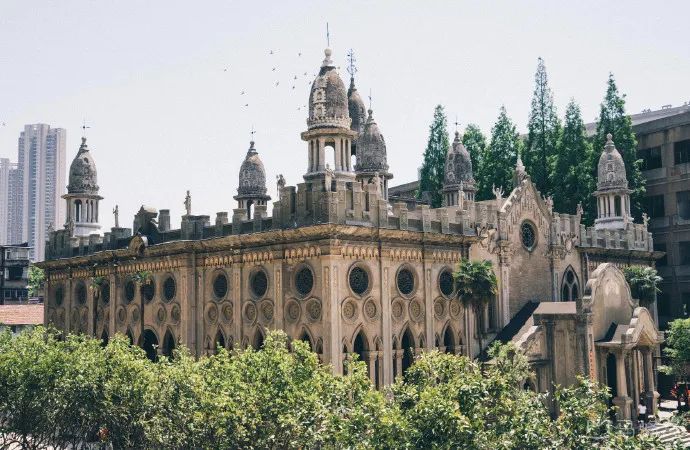
- A temple with a strong exotic architectural style.
- Ticket: Free
- Opening hours: 08:30-16:00
Wuhan Yangtze River Bridge

- The “First Bridge across the Yangtze River.”
- Ticket: Free
- Opening hours: All day
East Lake Scenic Area
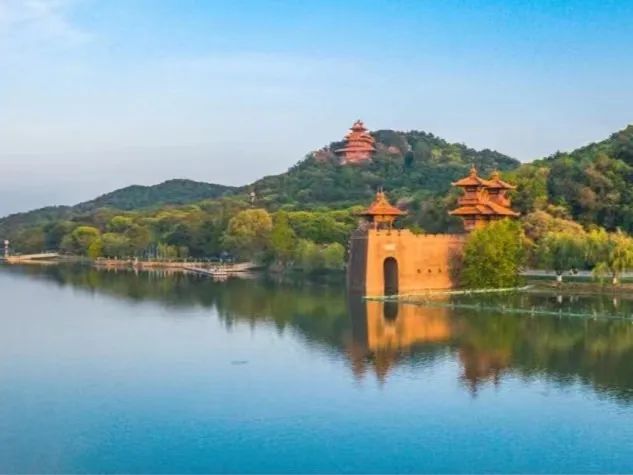
- The second-largest urban lake in China.
- Ticket: Free
- Opening hours: All day
Lihuangpi Road
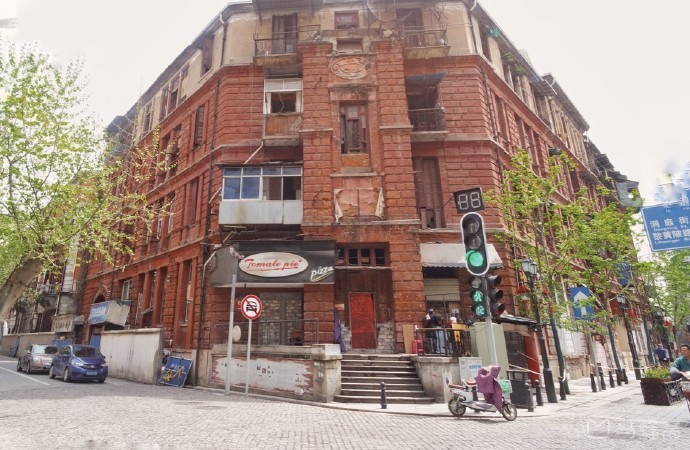
- A retro and artistic street with numerous creative shops.
- Ticket: Free
- Opening hours: All day
Tan Hua Lin

- An art village that is a must-visit for artistic youth.
- Ticket: Free
- Opening hours: All day
Liangdao Street
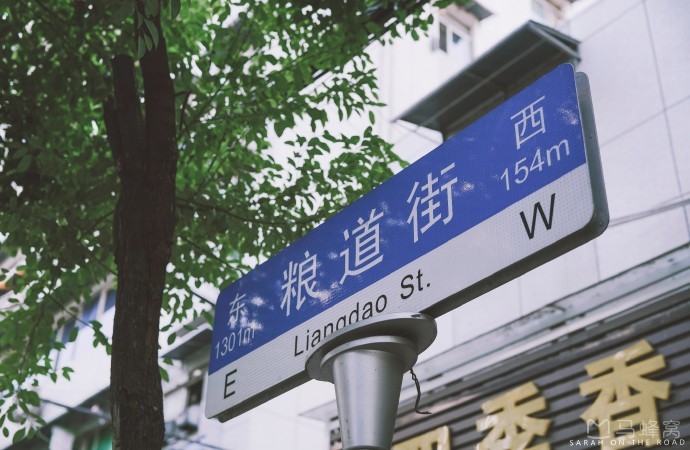
- A street with century-old famous schools in Wuhan and plenty of delicious food.
- Ticket: Free
- Opening hours: All day
Jianghan Road

- A prosperous century-old commercial street.
- Ticket: Free
- Opening hours: All day
Qingchuan Pavilion

- Known as one of the “Three Best Sceneries in Chu,” along with Yellow Crane Tower and Guqin Terrace, it is one of the three famous scenic spots in Wuhan.
- Ticket: Free
- Opening hours: All day
Two Rivers Cruise in Wuhan
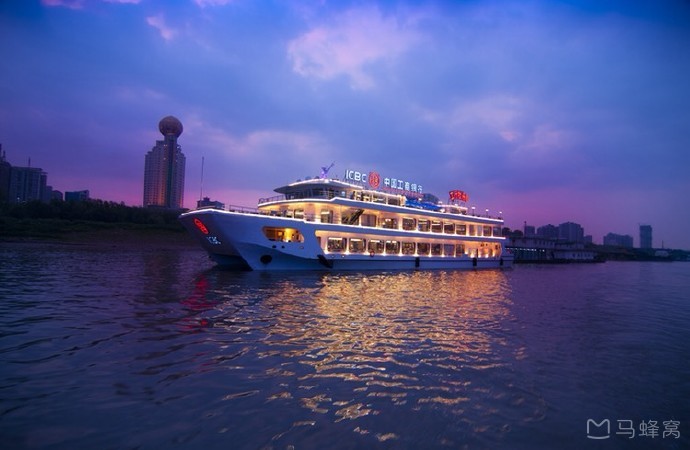
- Enjoy the cool breeze while cruising along the Yangtze River at night.
- Ticket: 90 yuan and up
- Opening hours: All day
Wuhan Happy Valley
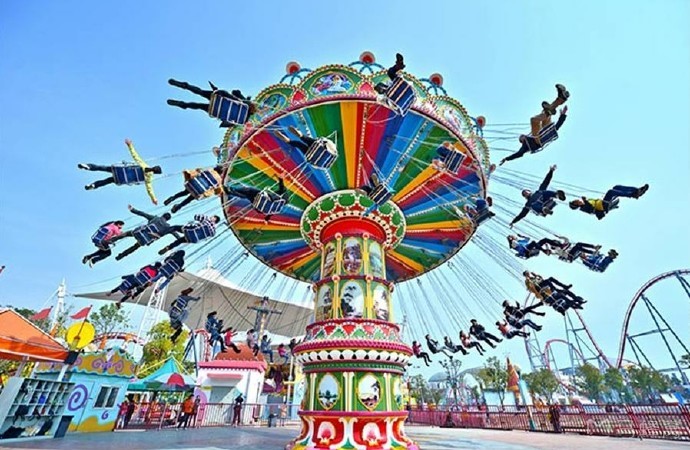
- Experience the thrill of speed at the Speed World.
- Ticket: 99 yuan and up
- Opening hours: 9:00-22:00
Hubei Provincial Museum
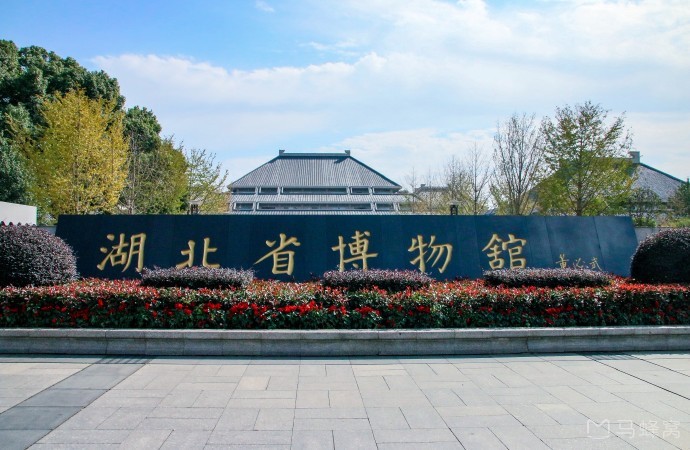
- Showcasing Ming and Qing Dynasty architectural styles.
- Ticket: Free (reservation required in advance)
- Opening hours: 9:00-18:00 (closed on Mondays)
Hubei Art Museum

- Gathering high-quality exhibition works.
- Ticket: Free
- Opening hours: 9:00-17:00 (closed on Mondays)
Hubu Alley
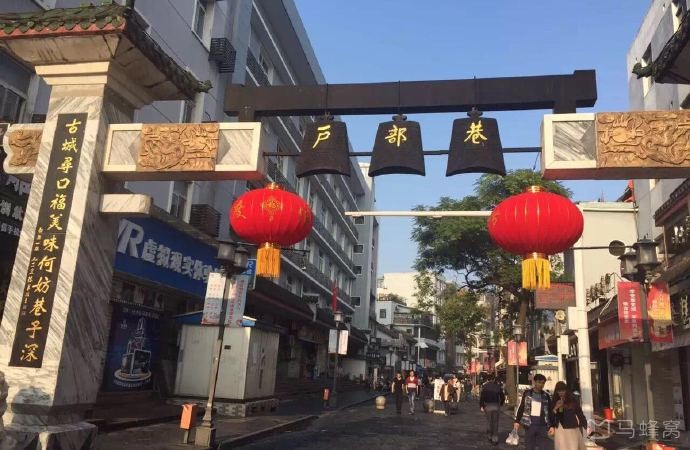
- A centuries-old alley about 150 meters long, featuring numerous famous Wuhan snacks.
- Ticket: Free
- Opening hours: All day
Wuhan University

- Renowned for its cherry blossoms and English country villa-style architecture.
- Ticket: Free (reservation required in advance)
- Opening hours: All day
Chu River and Han Street
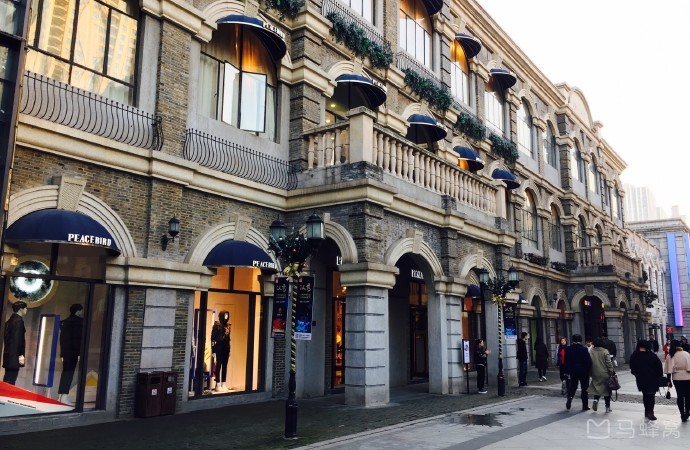
- The most architecturally distinctive urban commercial pedestrian street in China.
- Ticket: Free
- Opening hours: All day
3-Day Wuhan Travel Itinerary
Day 1: Liangdao Street → Tan Hua Lin → Yellow Crane Tower → Hubu Alley → Wuhan Yangtze River Bridge / Parrot Island Yangtze River Bridge
Day 2: Hubei Provincial Museum → Hubei Art Museum → East Lake Scenic Area (optional) → Wuhan University → Chu River and Han Street / Optics Valley Plaza
Day 3: Gudetama Temple → Lihuangpi Road → Qingchuan Pavilion → Jianghan Road Pedestrian Street → Riverbank
DAY 1
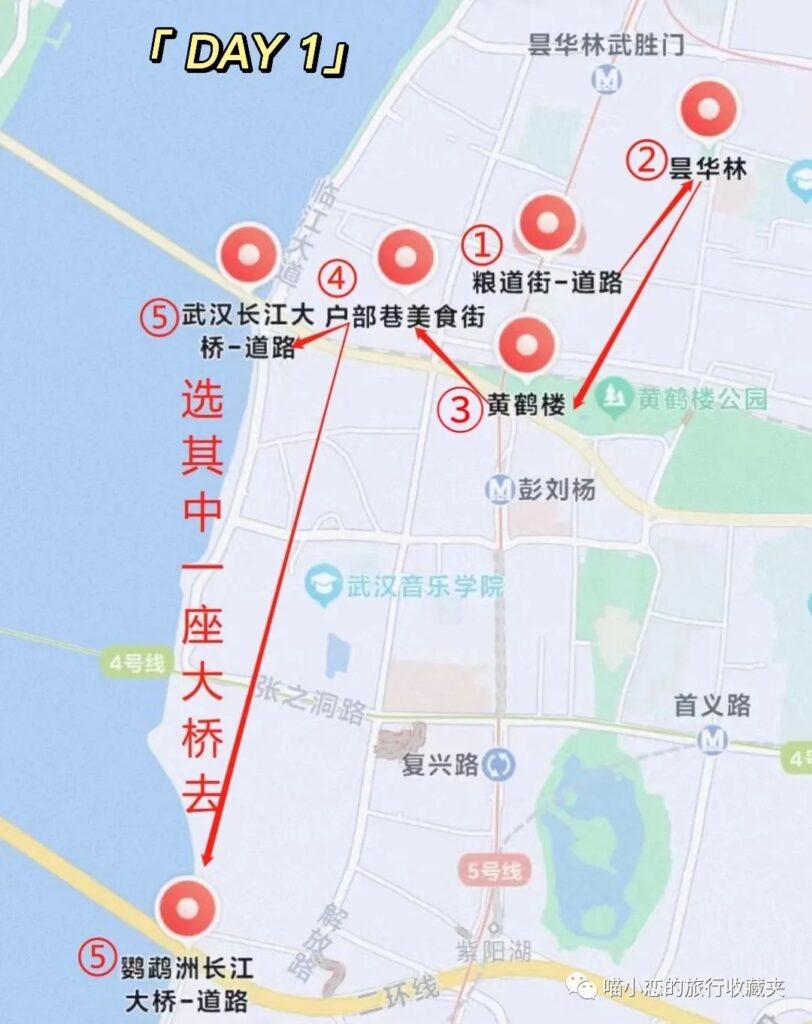
Liangdao Street
Experience Wuhan’s “Guo Zao” (breakfast) culture and savor various breakfast dishes such as tofu skin, hot dry noodles, soup noodles, tossed noodles, oil cake with steamed dumplings, crispy dumplings, Tiao noodle nest, and egg wine. Enjoy the pleasure of eating while walking.

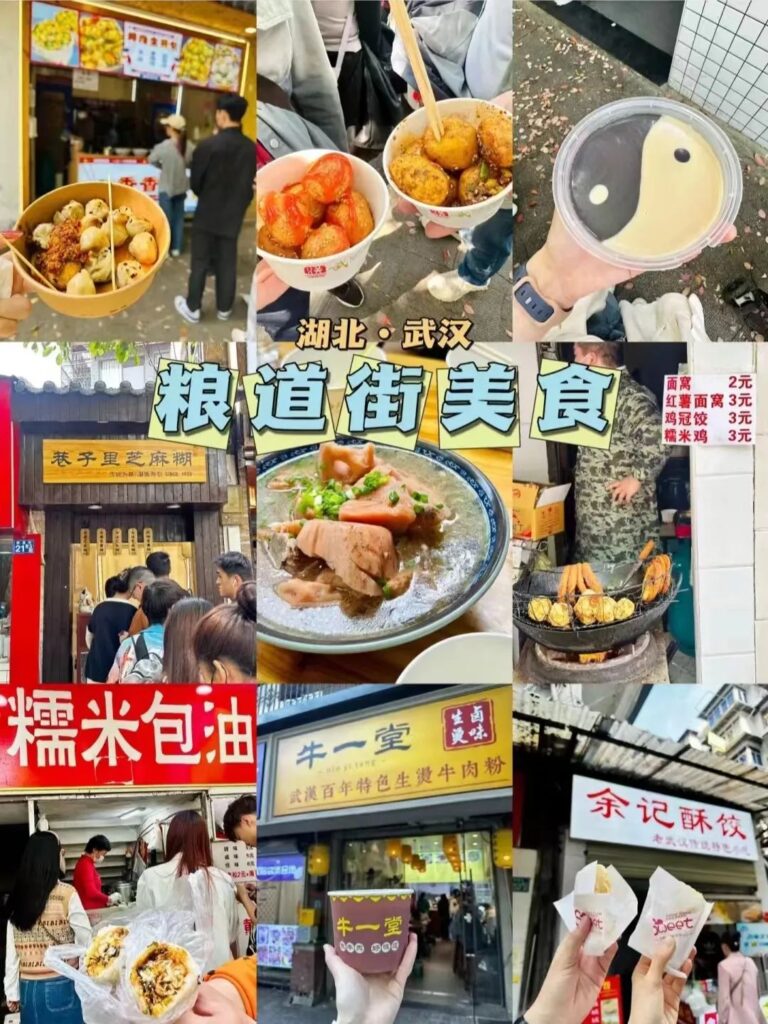
Tan Hua Lin
Tan Hua Lin is known as Wuhan’s “most artistic street,” boasting a beautiful environment, long history, and cultural gathering. It’s perfect for taking photos and checking in.
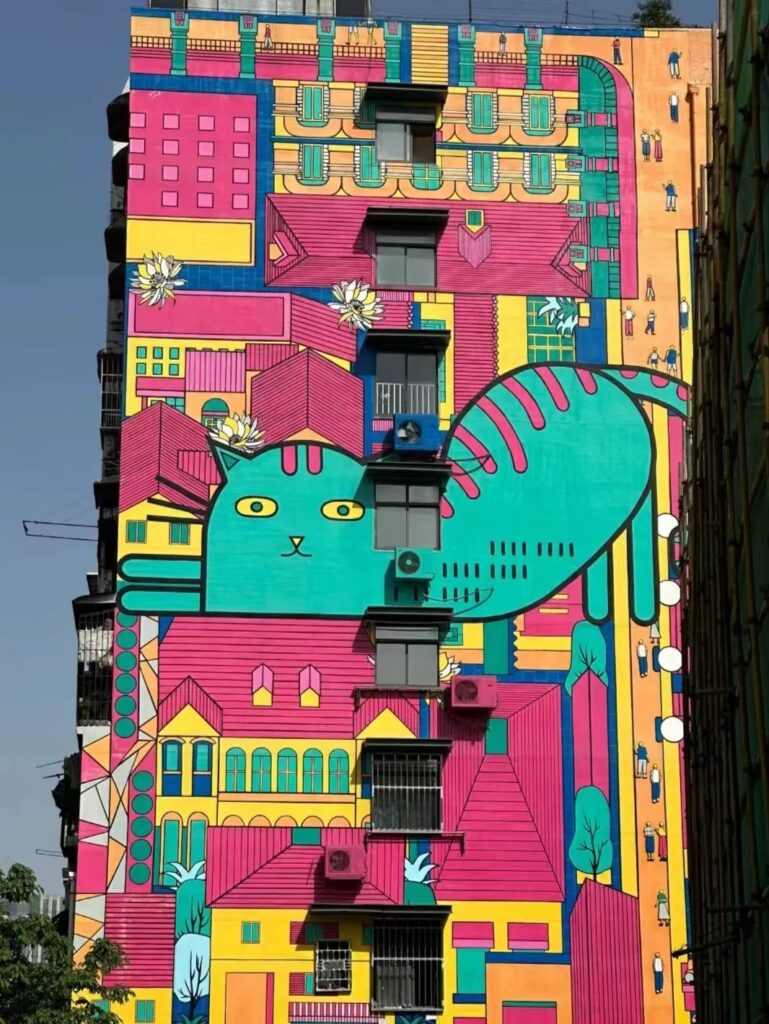
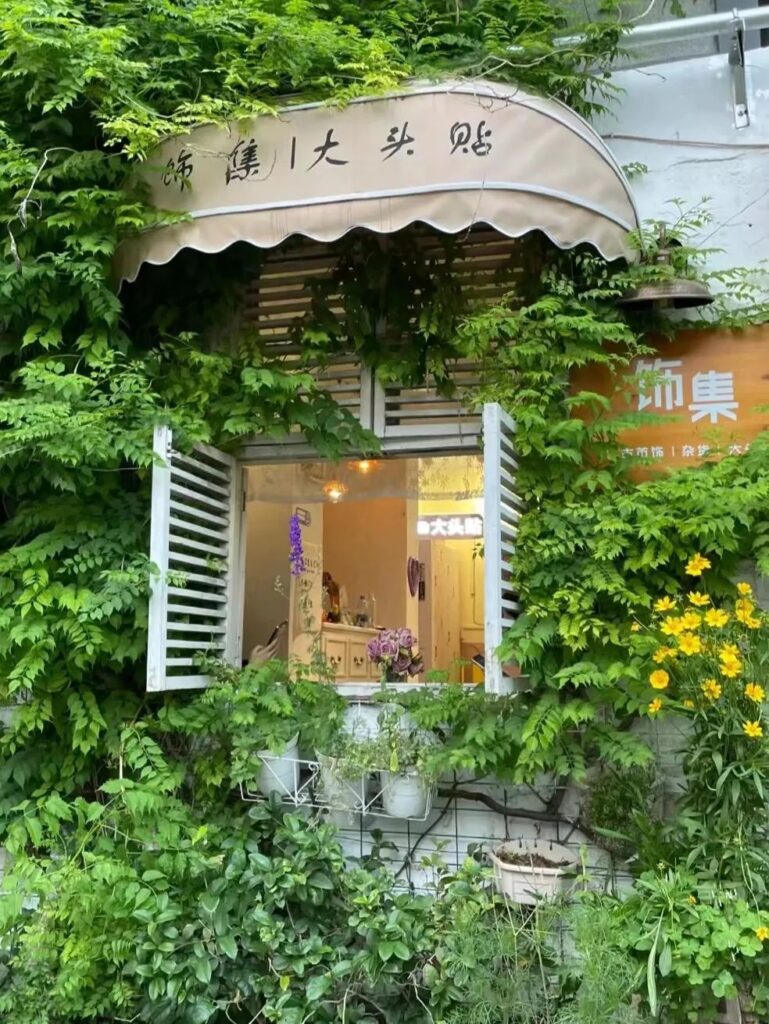
Yellow Crane Tower
The daytime ticket costs 65 yuan, while the evening ticket is 120 yuan. Purchase tickets on Meituan, Dianping, or the official WeChat account (“Yellow Crane Tower”) at least one day in advance. Enjoy the scenery during the day and watch the light show at night.
- ✅ For those interested in history, it is recommended to choose the daytime visit, as there are cultural landscapes such as the Poetry Stele Corridor and Baiyun Pavilion.
- ✅ Photo spots for Yellow Crane Tower without entering the scenic area:
- Exit C of Simenkou Yellow Crane Tower Station (see the image on the bottom right)
- Simenkou Overpass (follow the steps to the head of the Yangtze River Bridge)
- The sentry box at the head of the Wuchang Yangtze River Bridge (go up the bridge from the Simenkou Overpass)
- The head of the Wuchang Yangtze River Bridge (go up the bridge from the Wuhan Yangtze River Bridge Completion Memorial)
- In the alley of Desheng Bridge (at the intersection with Liangdao Street)

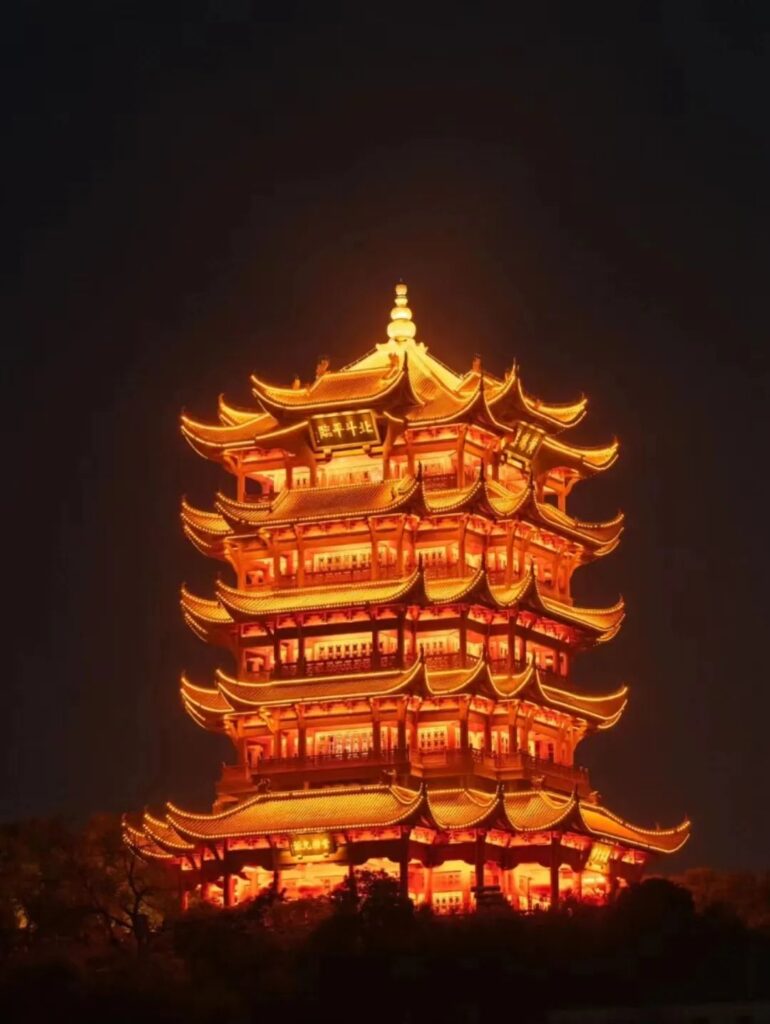
Hubu Alley
It is heavily commercialized, and the snacks inside are not recommended due to high prices. However, since it is close to the Yellow Crane Tower, you can pass by and check in to experience the atmosphere of the snack street.
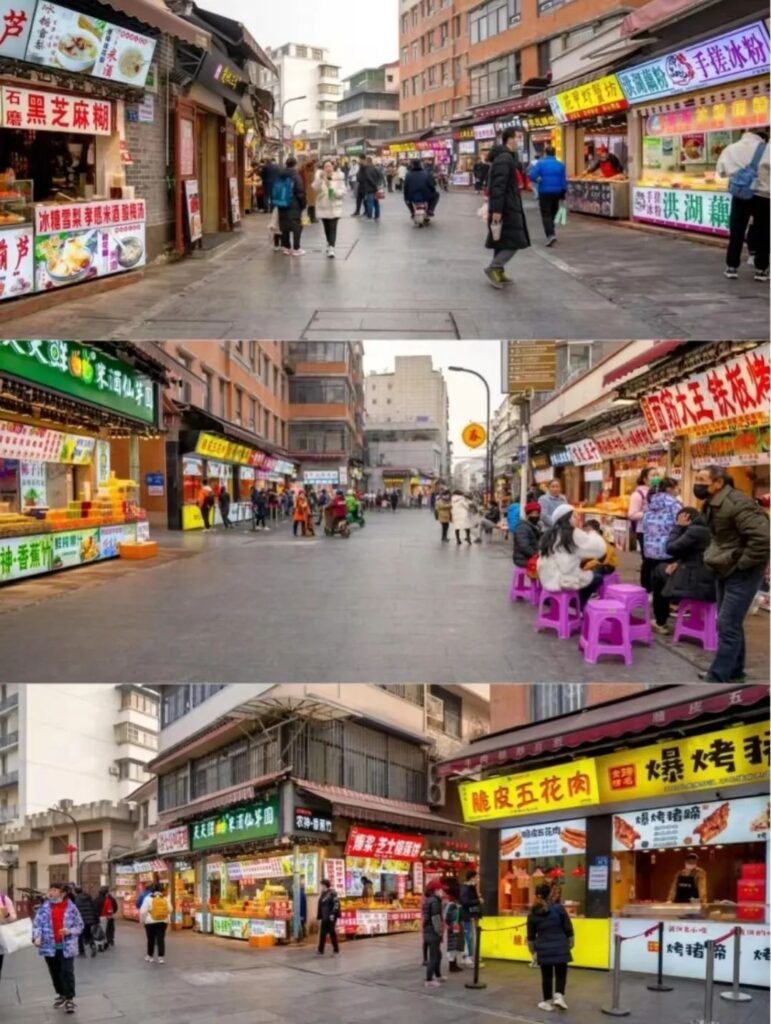
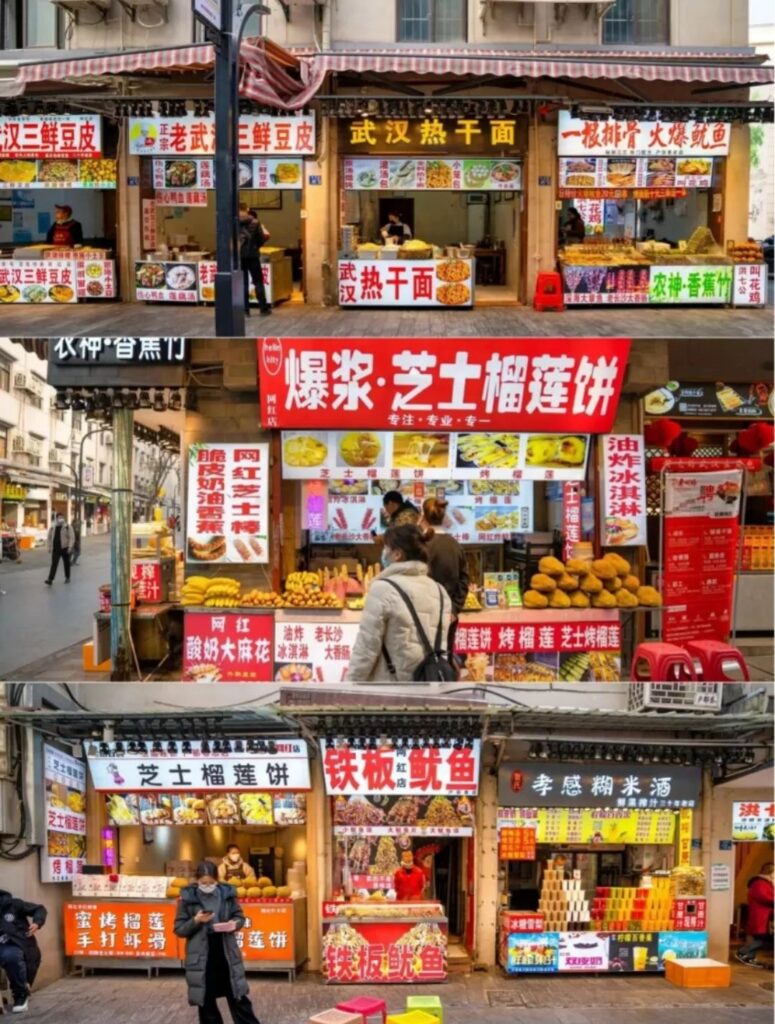
Wuhan Yangtze River Bridge / Parrot Island Yangtze River Bridge
✅ Wuhan Yangtze River Bridge (Image 1): The first bridge across the Yangtze River and one of Wuhan’s landmarks. The sunset view is beautiful in the evening.
✅ Parrot Island Yangtze River Bridge (Image 2): The orange-red main tower, accompanied by the wide river, is particularly magnificent, especially at night when the lights are on, giving the River City a charming allure!
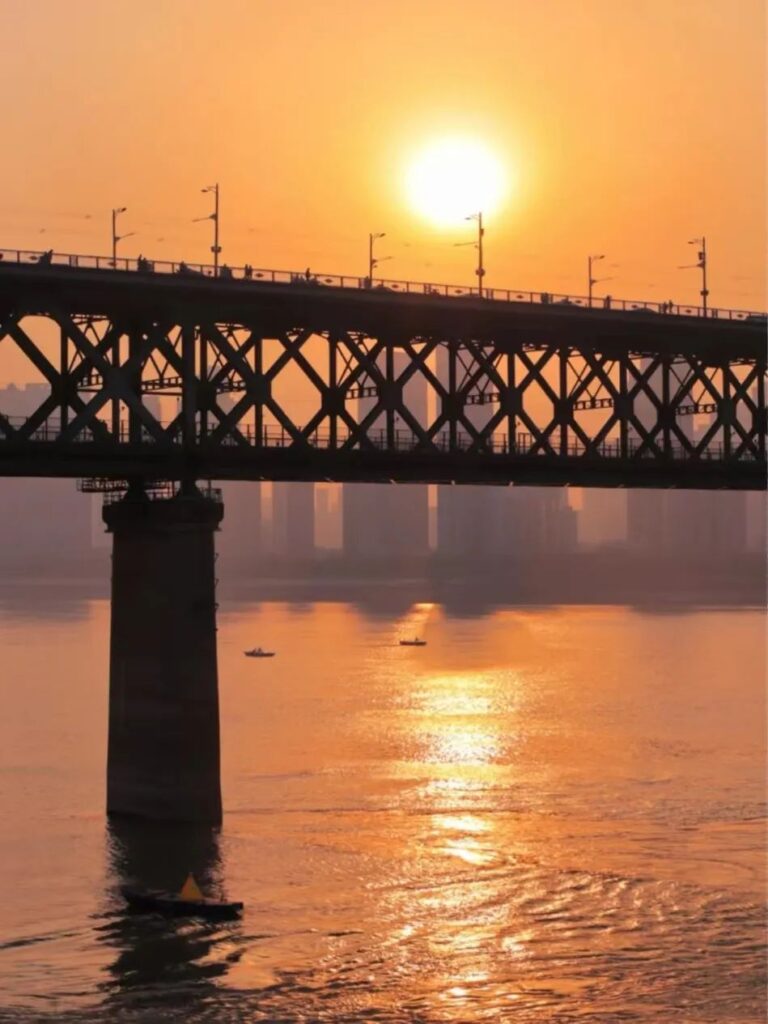
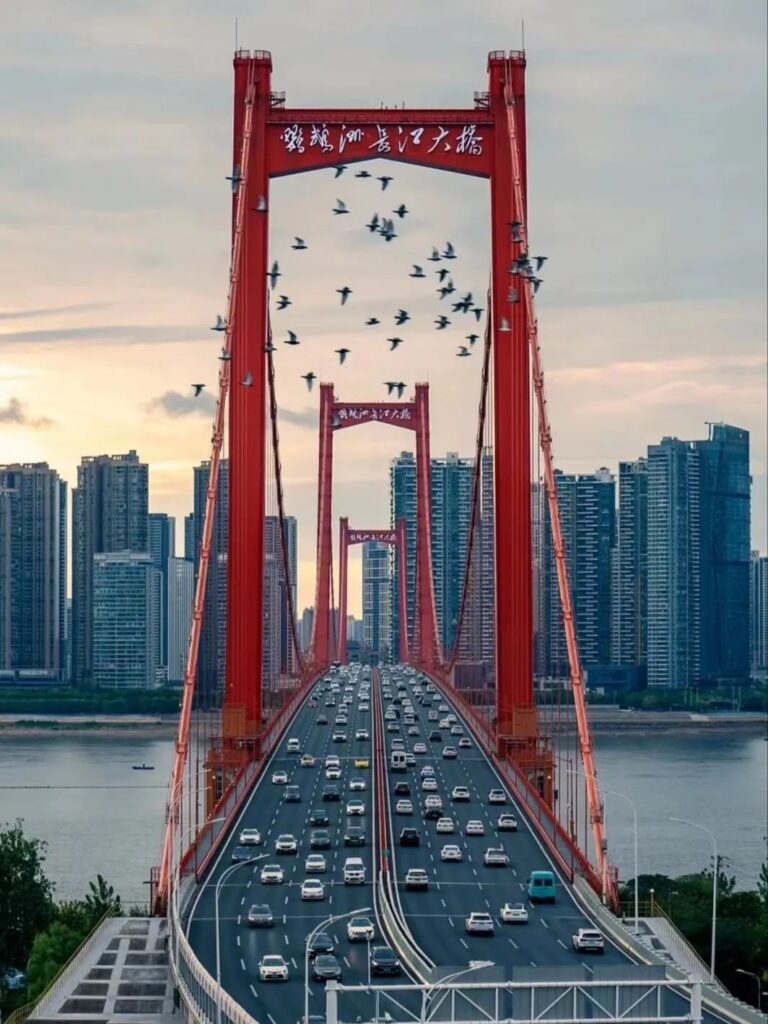
DAY 2
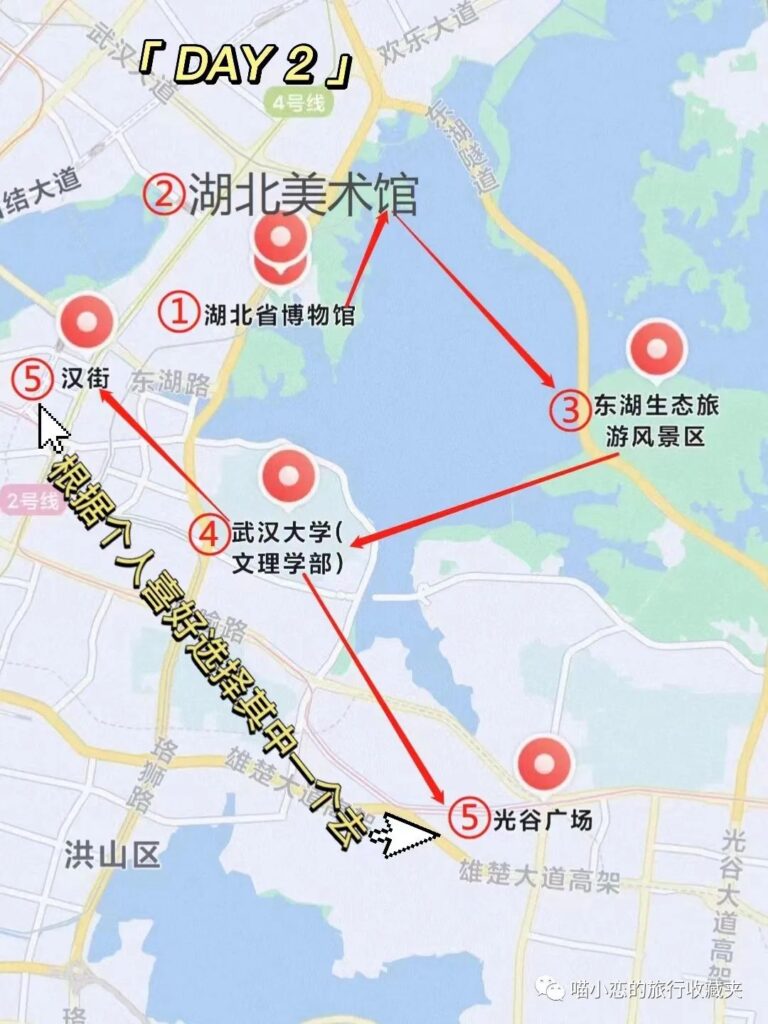
Hubei Provincial Museum
Closed on Mondays! Admission is free. It houses ten famous treasures, including the Sword of Goujian, King of Yue, and the Marquis Yi of Zeng Bells. You can also enjoy a wonderful performance of the chime bells, but tickets need to be purchased on-site.
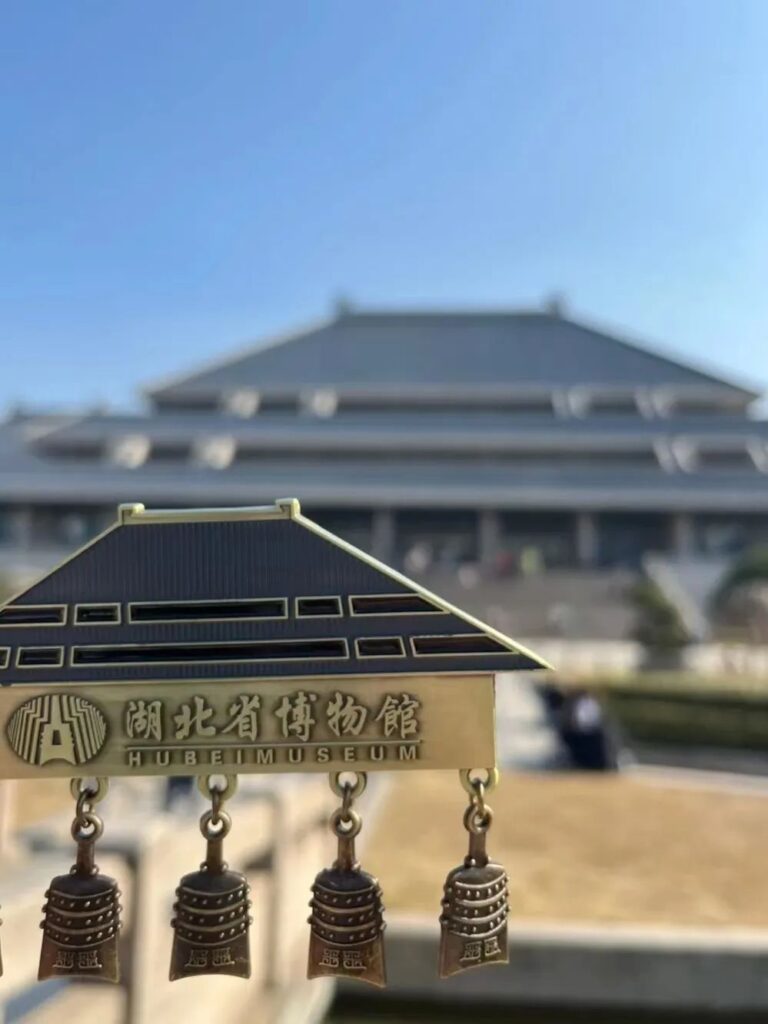
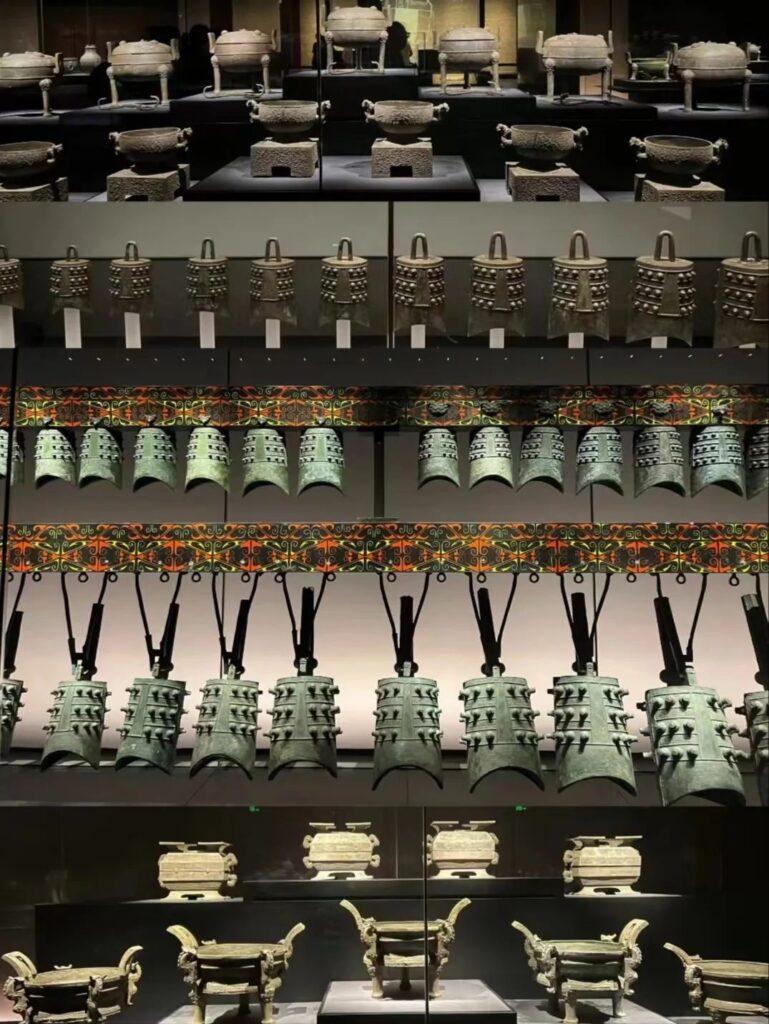
Hubei Art Museum
Gather high-quality exhibitions and experience a strong artistic atmosphere. The art museum is close to the provincial museum. Make a reservation in advance through the WeChat official account “Hubei Art Museum.” Closed on Mondays. Admission is free.
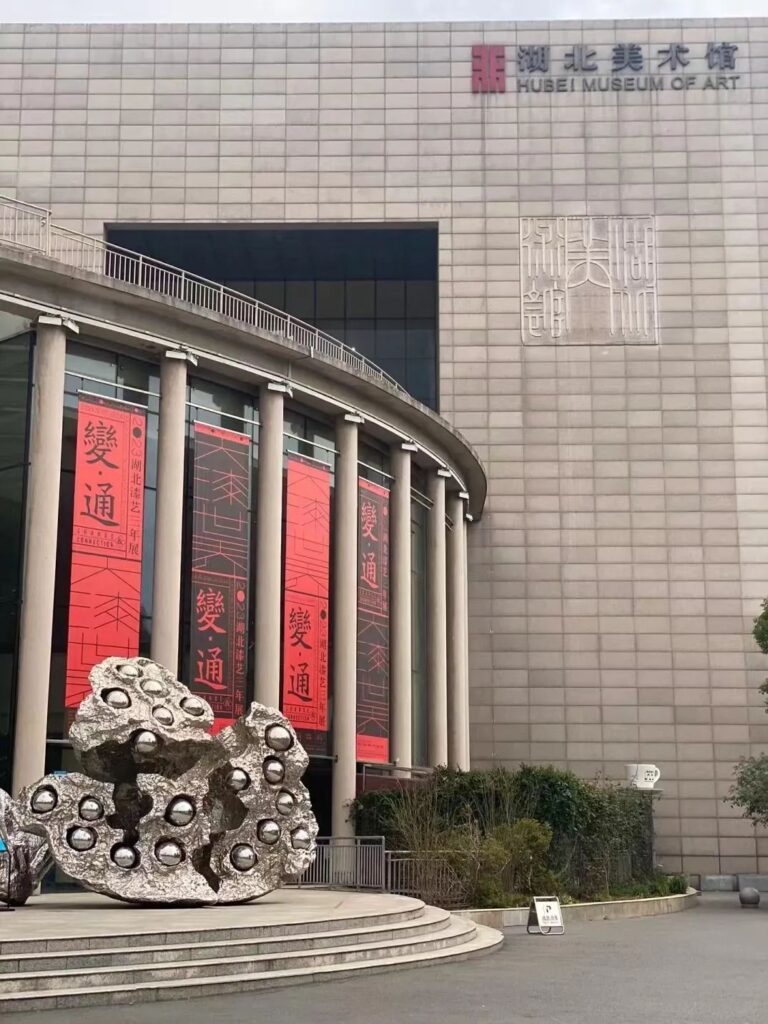
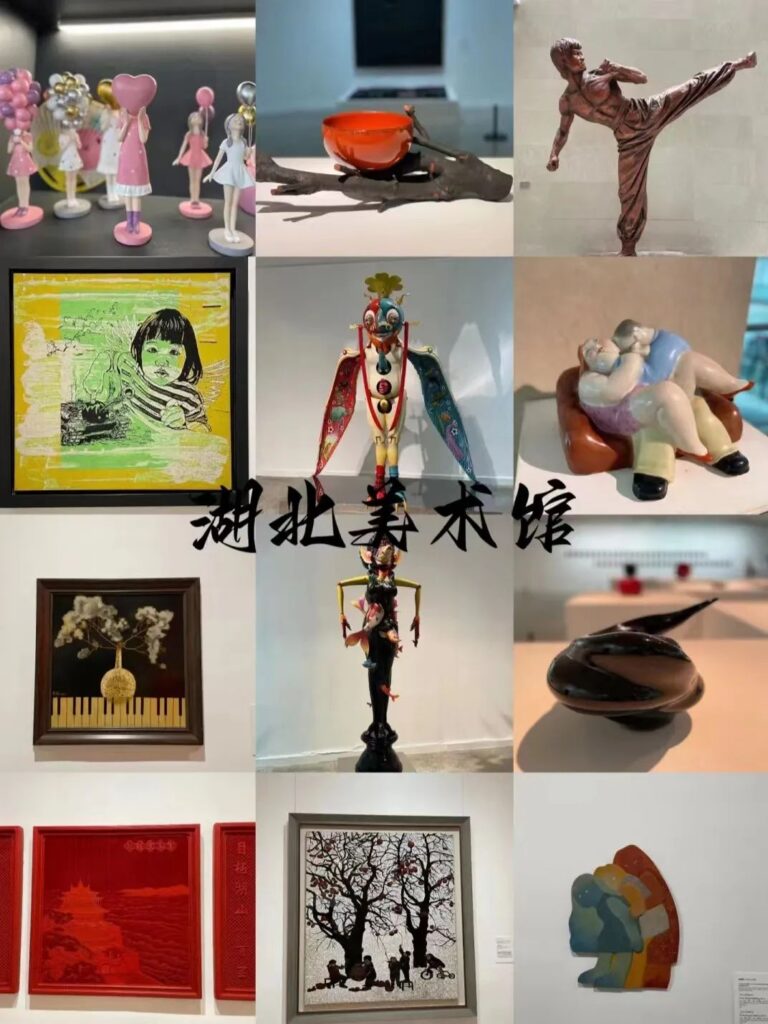
East Lake Scenic Area
It is the second-largest urban lake in China and the largest ecological park in Wuhan. It is divided into four areas: Tingtao Scenic Area, East Lake Moshan Scenic Area, Luoyan Scenic Area, and Chuidi Scenic Area. The biggest feature of East Lake is its vastness. Generally, choosing one scenic spot to visit is enough, and you can spend an afternoon there. Rent a bicycle with friends for a leisurely ride. The scenery is even better on a nice day. If your itinerary is tight, you can skip this.
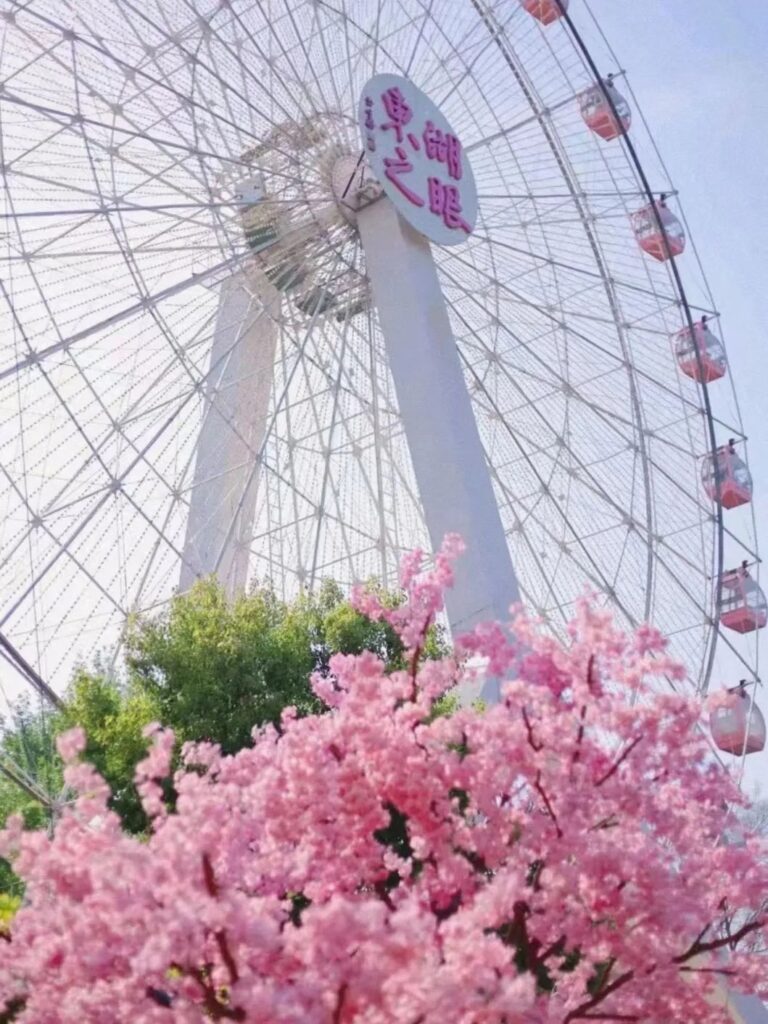
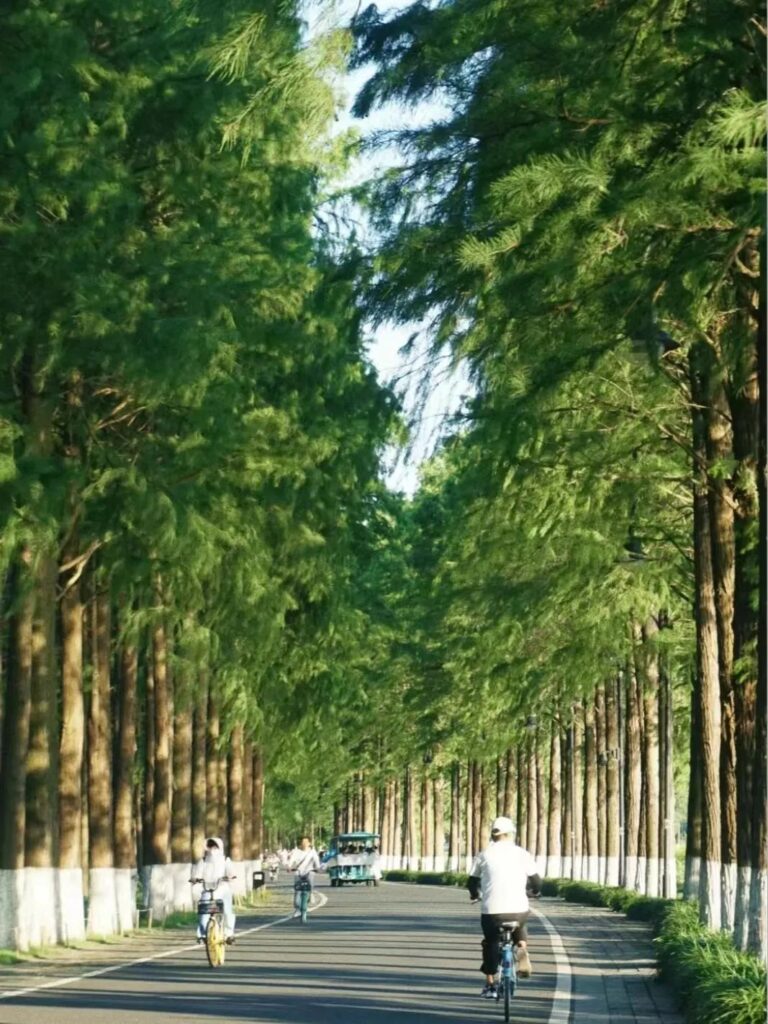
Wuhan University
Wuhan University is currently not open to the public. If you have a famous school complex, you can check in at the entrance and take a photo as a souvenir.
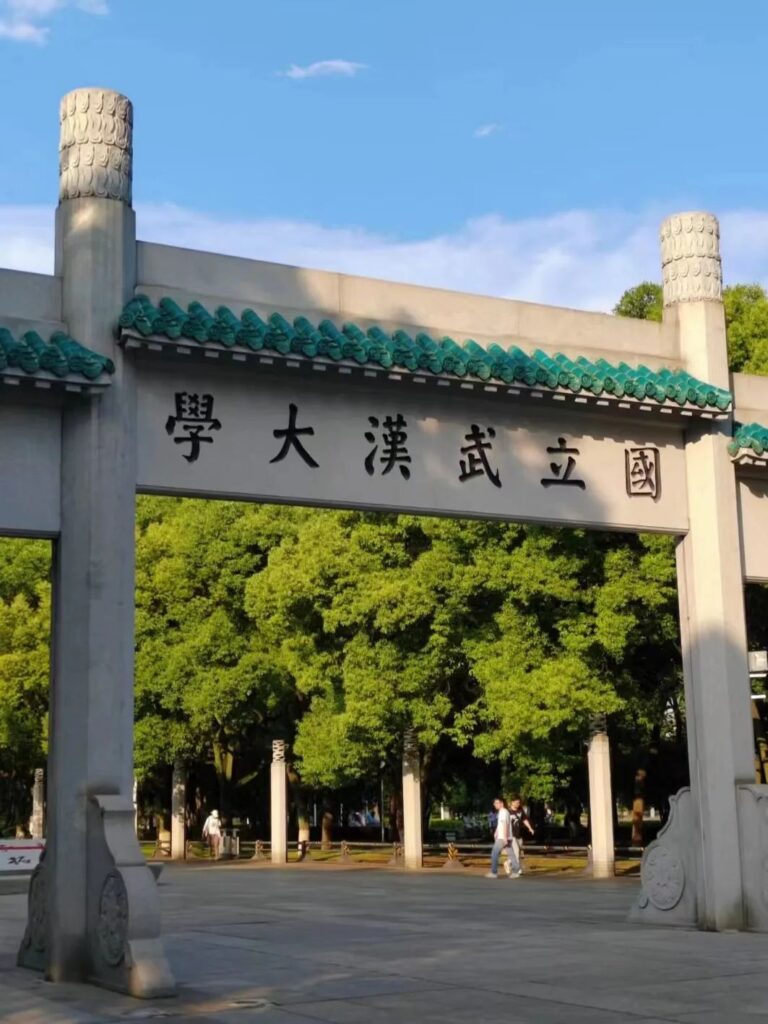
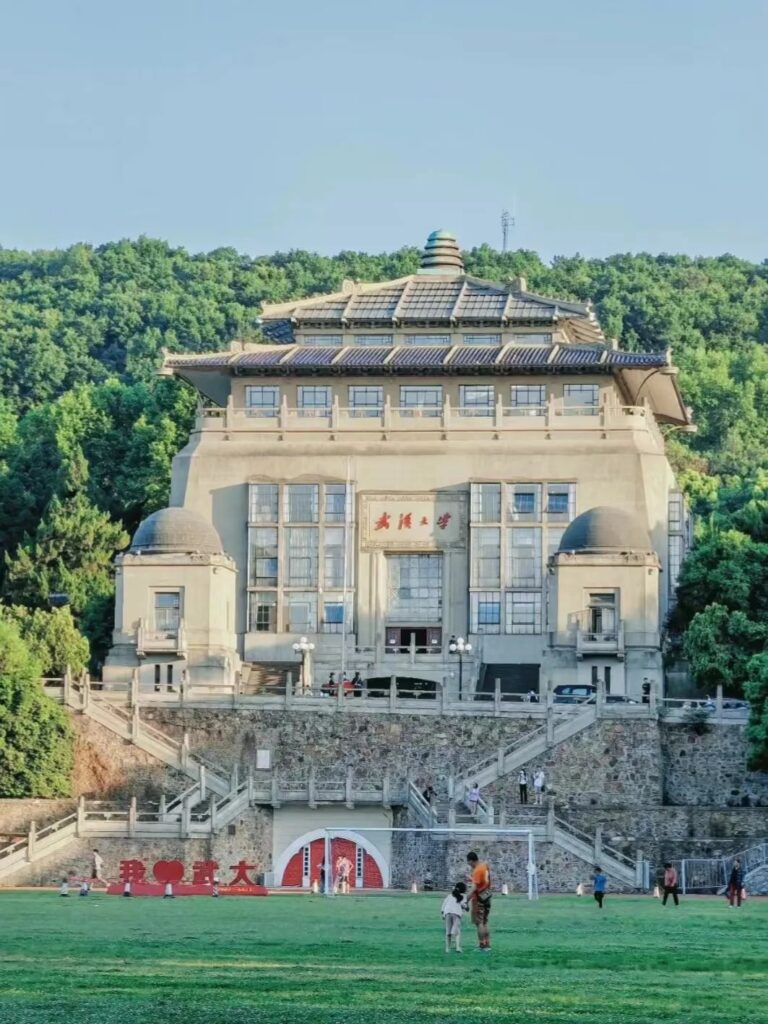
Chu River and Han Street / Optics Valley Walking Street
✅ Chu River and Han Street (Image 1): A European-style commercial street that integrates food, drink, and shopping. It is also photogenic.
✅ Optics Valley Walking Street (Image 2): It is far from the city center but has romantic exotic architecture that makes for great photos.

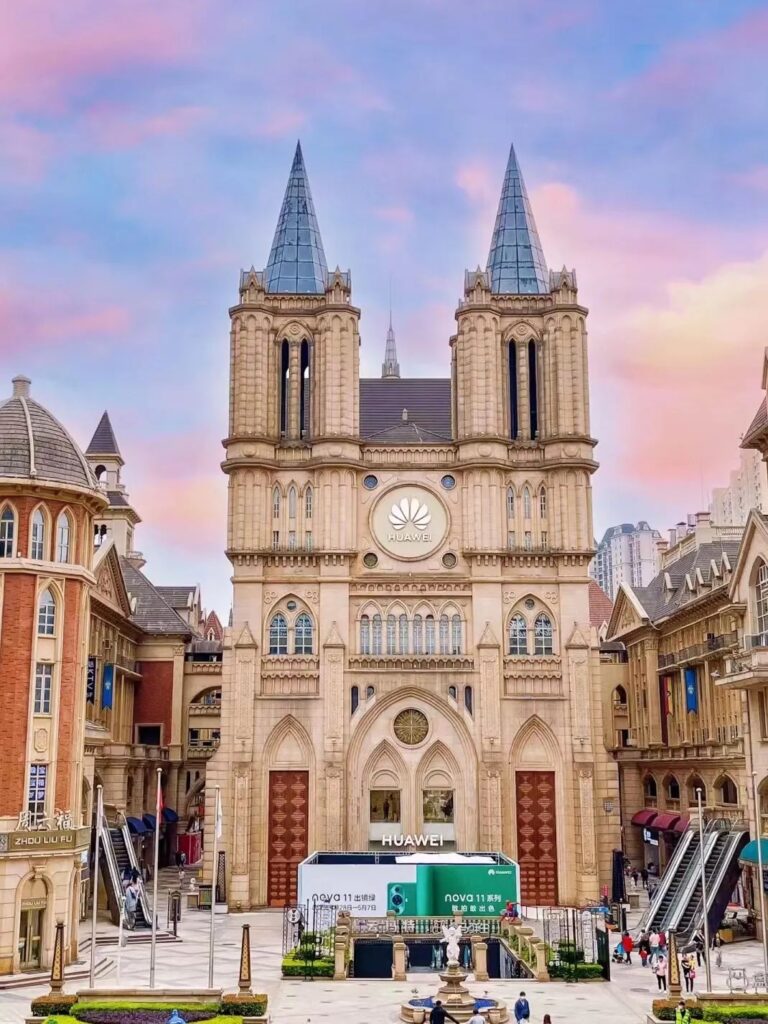
DAY 3

Gudetama Temple
You can first have breakfast on Shanhaiguan Road and then head to Gudetama Temple. The temple has a strong exotic architectural style. Admission is free, but reservations need to be made in advance through the WeChat official account. The incense money is around 10 yuan. Overly revealing clothing is prohibited.

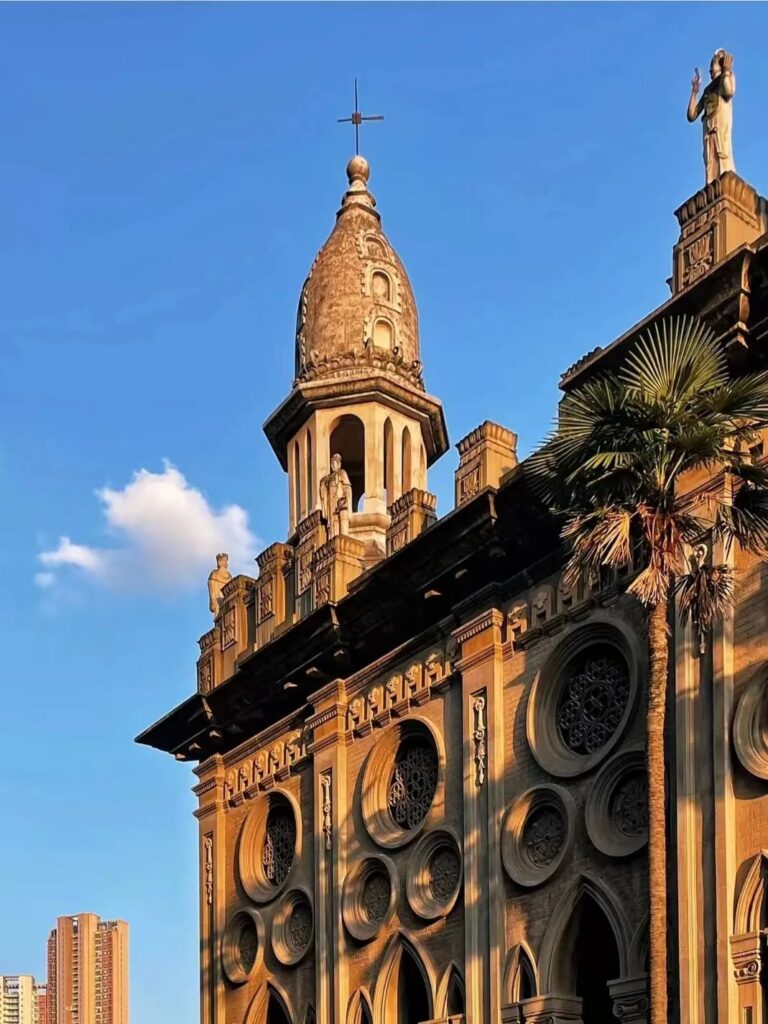
Lihuangpi Road
As a former concession, every brick and tile exudes a strong historical trace. The old red-brick houses are full of artistic and retro sentiments. There are also many coffee shops and small workshops on both sides of the street.


Qingchuan Pavilion
Scan the QR code at the entrance for reservation. Qingchuan Pavilion was first built during the Jiajing period of the Ming Dynasty and was named after the poem “Qingchuan Lili Hanyang Tree” by Cui Hao of the Tang Dynasty. The bamboo forest, cool pavilions, towers, and large red palace walls inside are all full of ancient elements. The architectural complex is majestic, and the scenery in the garden is beautiful. You can quietly appreciate the beauty of the ancient architecture and climb to the top of the pavilion to have a distant view of the Wuhan Yangtze River Bridge.
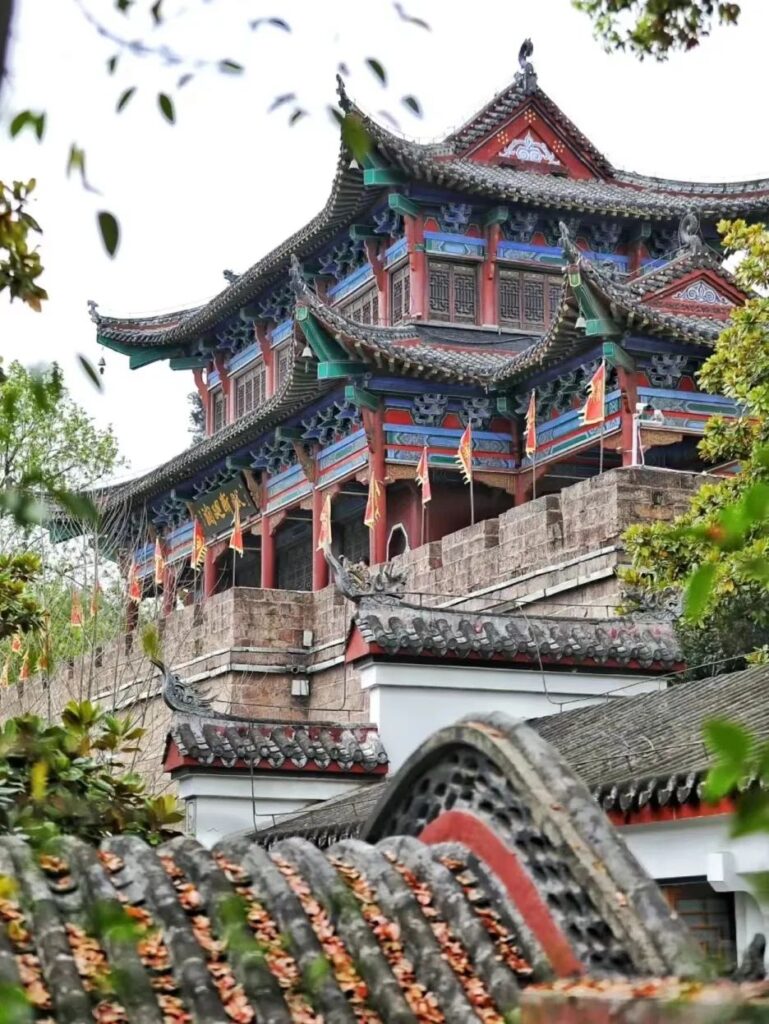
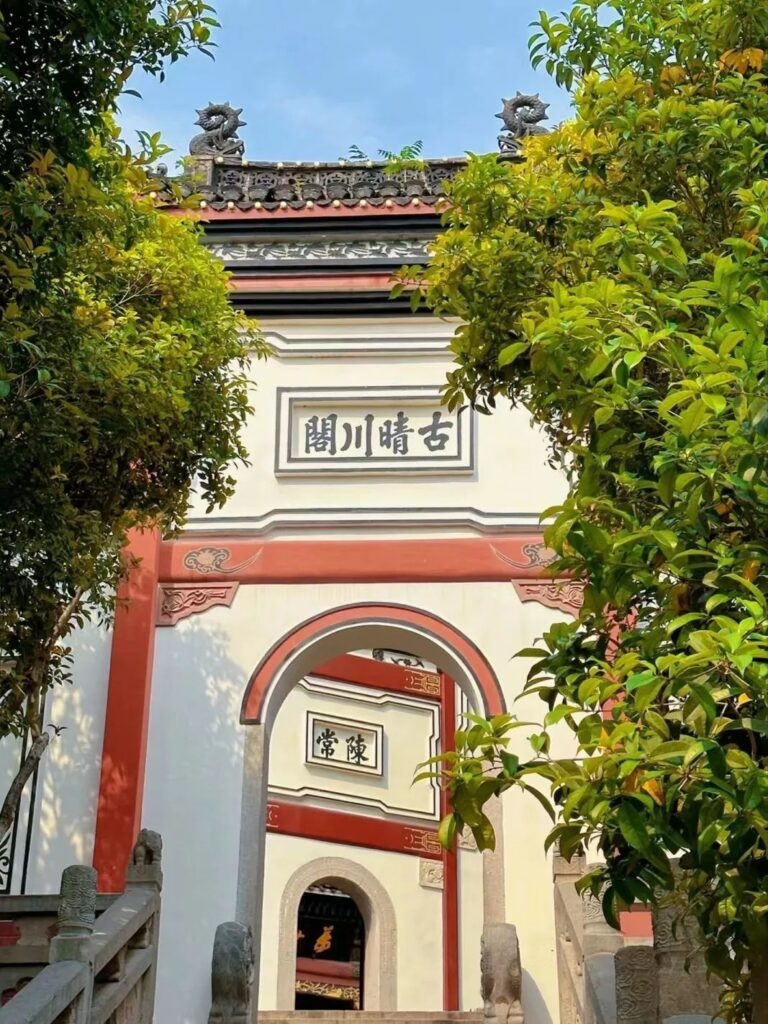
Jianghan Road Pedestrian Street
It features century-old European-style buildings and is an iconic check-in point. Nearby, there is also the Water Tower Street and Happy Food Station, gathering numerous delicacies.
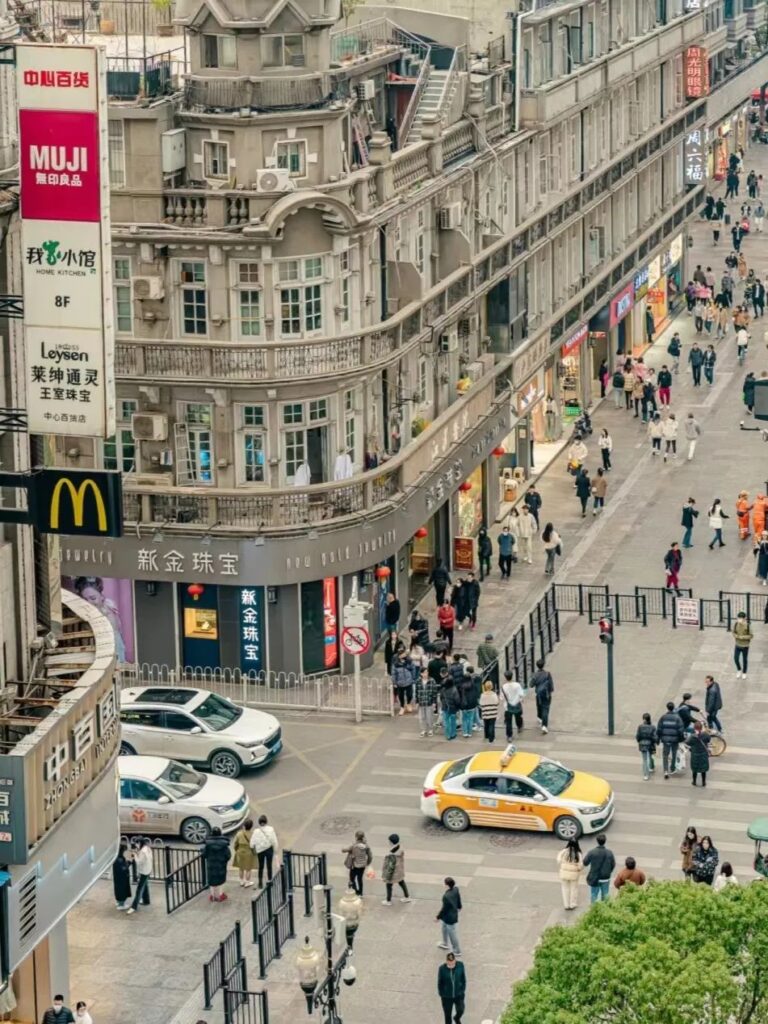
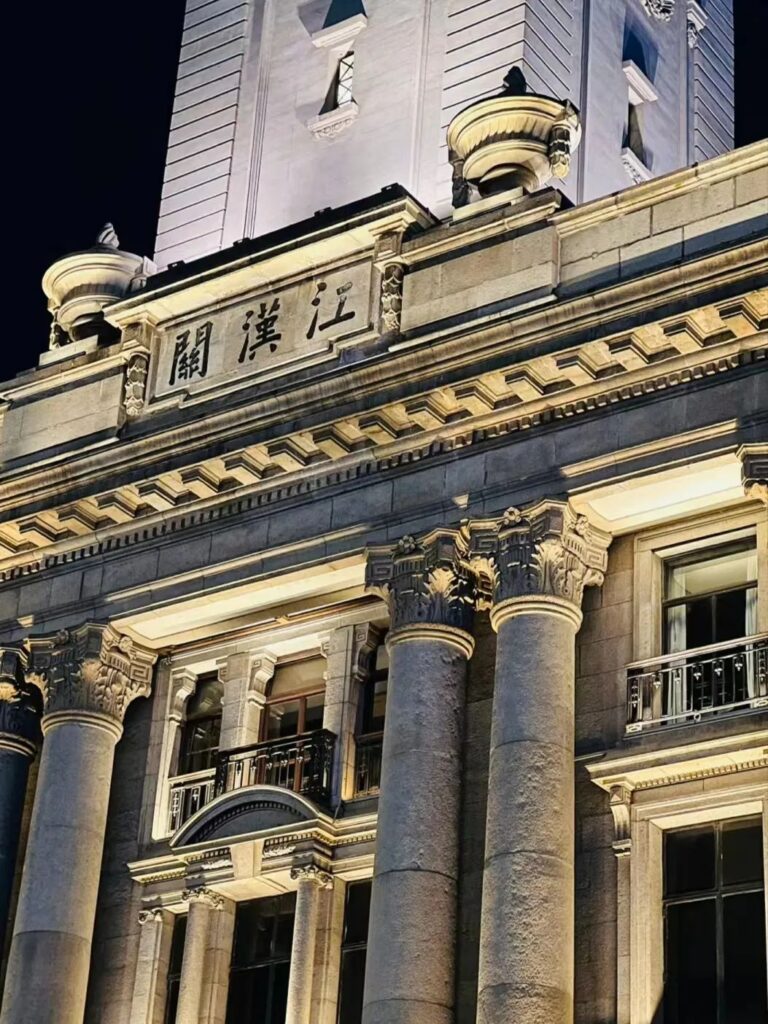
Hankou Riverbank
It is the longest riverbank park in the country and one of Wuhan’s landmark attractions. The scenery is very beautiful, and there is also a light show. It is suitable for evening walks and enjoying the night breeze.
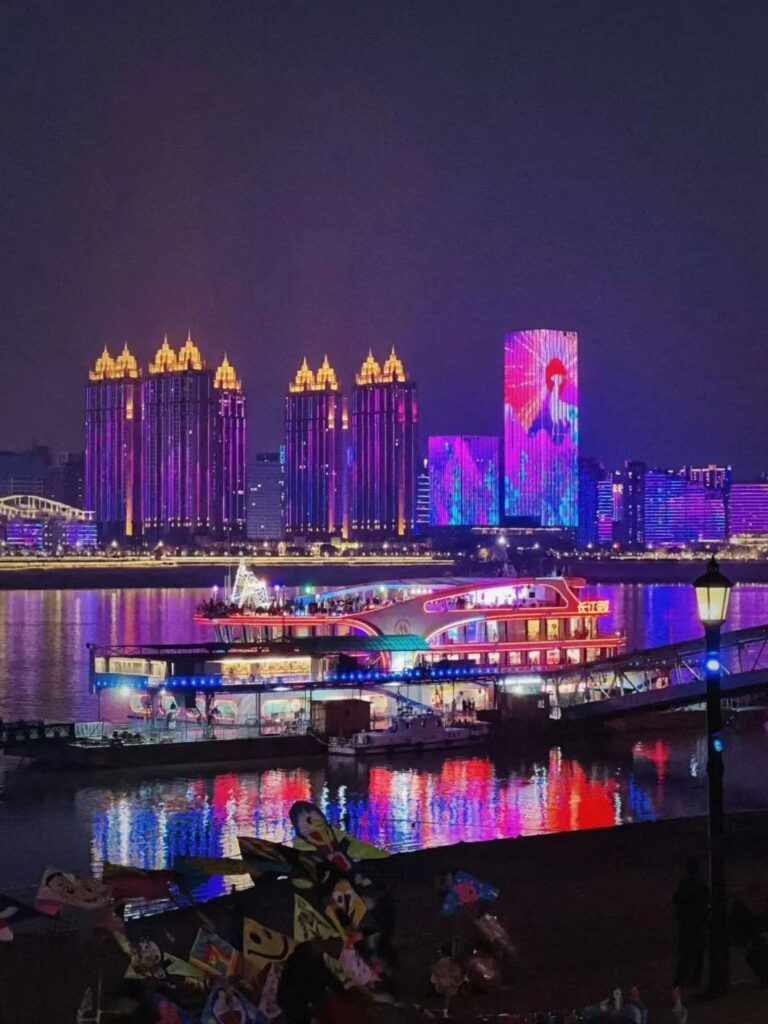
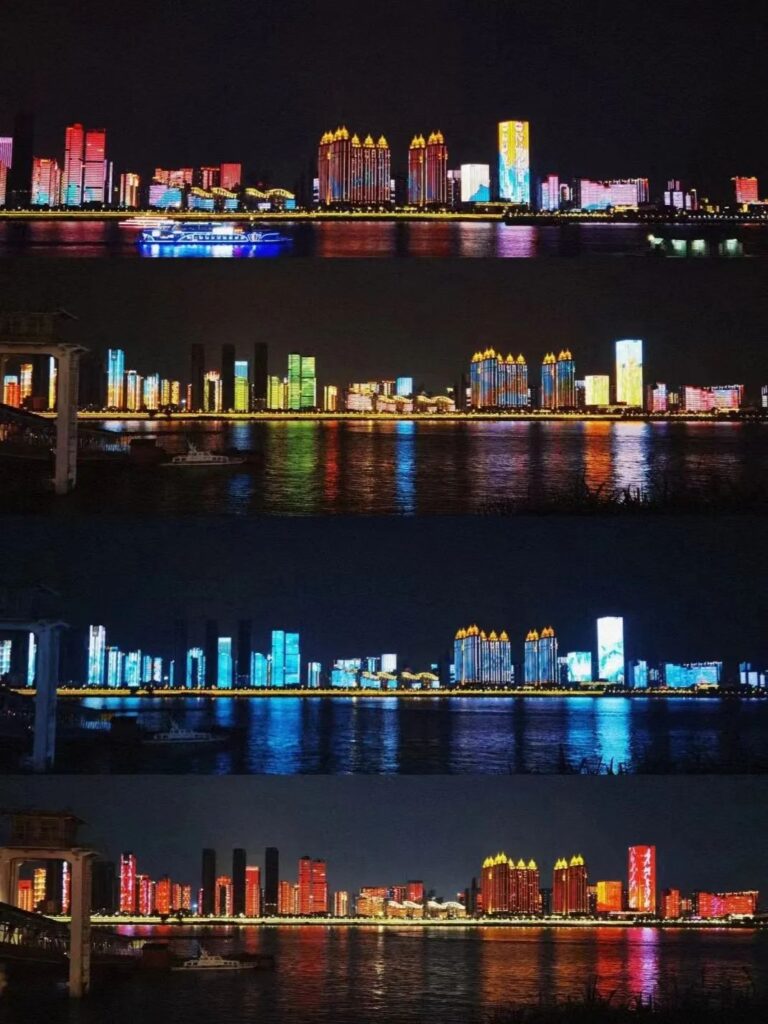
Wuhan Food Recommendations


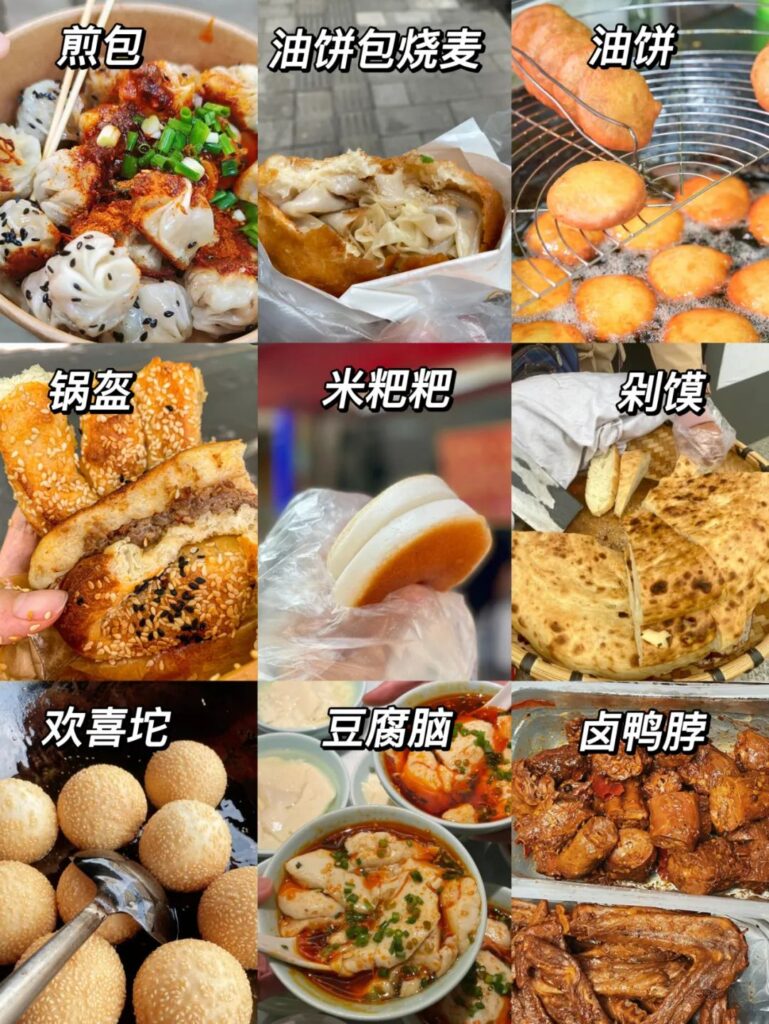
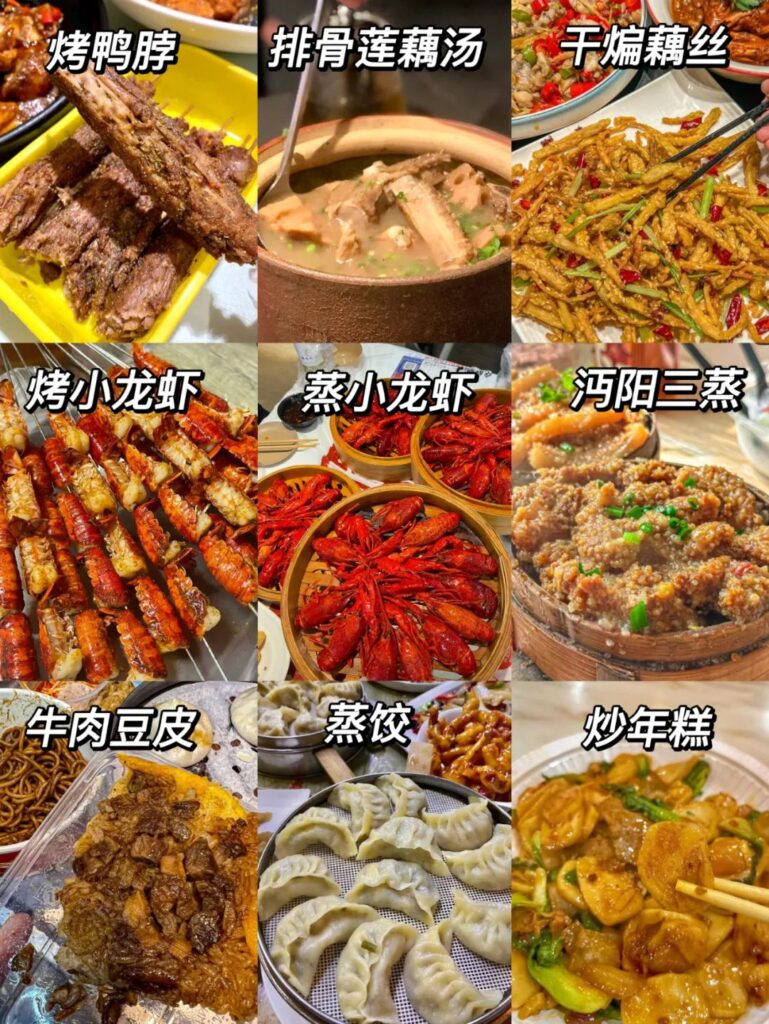
Wuhan Food Street Collection
- Hubu Alley: It’s not that you can’t go, but there are only a few good restaurants, and the prices are high… It’s indeed tidier after the renovation, but it’s still not fun. For Hanwei Spicy Hot Pot, Mapo Soup Buns, and Lao Qian Ji, go to the nearby Dacheng Road or the opposite Qinglong Alley.
- Jiqing Street: There used to be more food in the past, but now it’s not fun after the renovation. However, you can still give it a try, as the brand is still good. Check out Junjun, Dehua Tower, Lao Tongcheng, and Lao Wancheng.
- Wansongyuan: It’s a locally recognized food street, but the queues are too long, and the prices are too high, mainly focusing on shrimp restaurants. You can try the snacks.
- Liangdao Street: Not far from Hubu Alley, you can give it a try. There are many cheaper options. The problem is that most of the stores are now viral shops with long queues. There is a Smurf braised food store that is okay.
- Dacheng Road: Although this street is mainly fun for the night market, it’s actually quite delicious because there are fewer tourists. The short pancake at the intersection is very tasty when hot. Lihua Breakfast and Xiaoqiu Dumplings are highly cost-effective places for breakfast. Even the Cai Lin Ji here tastes better than elsewhere.
- Shipailing: Also mainly focuses on shrimp.
- Optics Valley Walking Street: Wuhan locals generally don’t go there to eat… unless they live nearby.
- Enshi Street: Qingshan’s food street. Many cooking methods combine the practices of other places in Hubei Province and even other provinces. However, the taste is indeed good, and the cost-performance ratio is very high.

Must-Visit Attractions
Wuhan perfectly blends highly representative historical culture with modern vibes. You haven’t truly been to Wuhan until you’ve checked in at these attractions.
Go see the Yangtze River Bridge that spans north and south
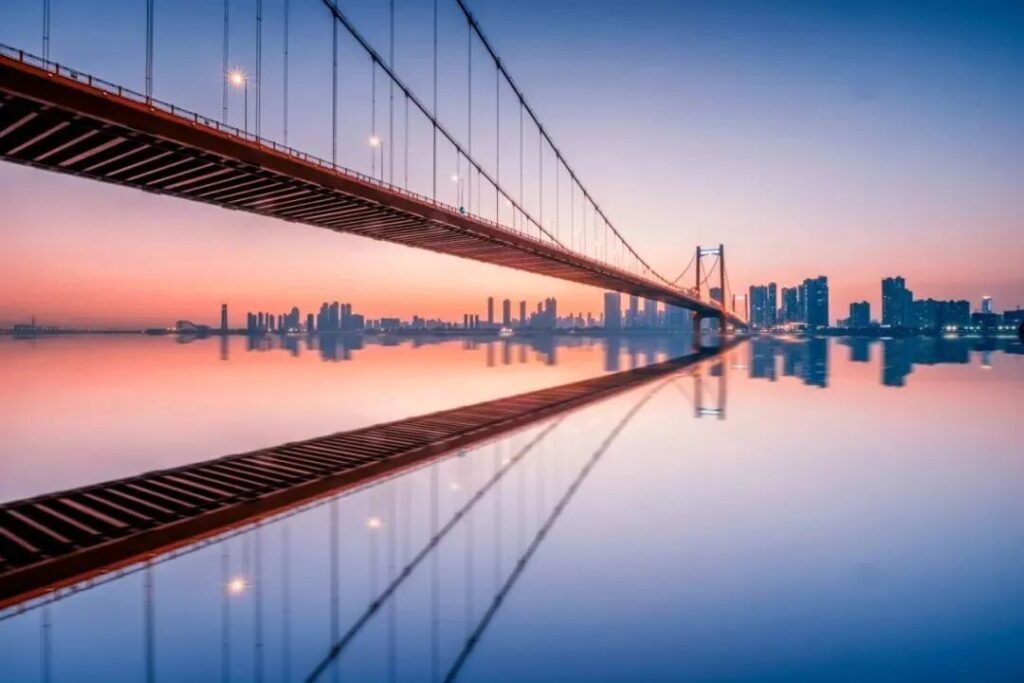
A bridge spans north and south, turning the natural moat into a thoroughfare. Known as the “First Bridge Across the Yangtze River,” the Wuhan Yangtze River Bridge has been in operation for over 60 years and is now a cultural relic.
Go see the Yellow Crane Tower from ancient poems
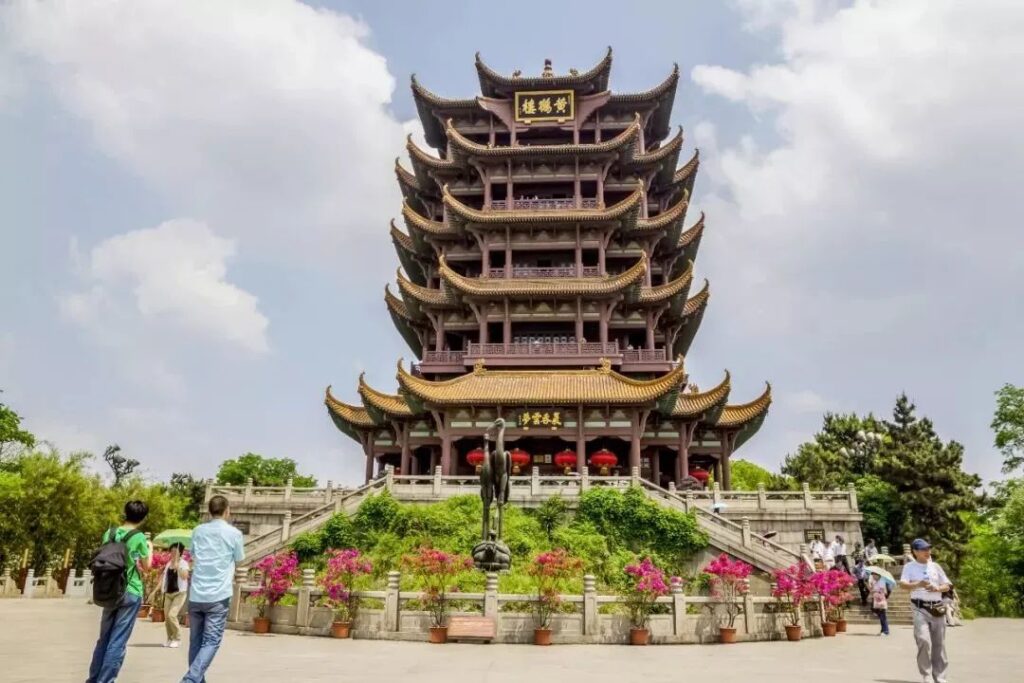
The old friend has left the Yellow Crane and gone, leaving only the Yellow Crane Tower here. As one of the “Three Famous Towers of Jiangnan,” the Yellow Crane Tower, along with the Qingchuan Pavilion and the Guqin Terrace, is known as the “Three Famous Scenic Spots of Wuhan.”
Go see the Chu River and Han Street full of Republican-era vibes

Red and gray fair-faced brick walls, exquisite brick-laid lines, black-lacquered large doors, bronze door knockers, and door lintels carved with Baroque-style swirling flowers…
Go see the winding lake shores and crisscrossing harbors of East Lake
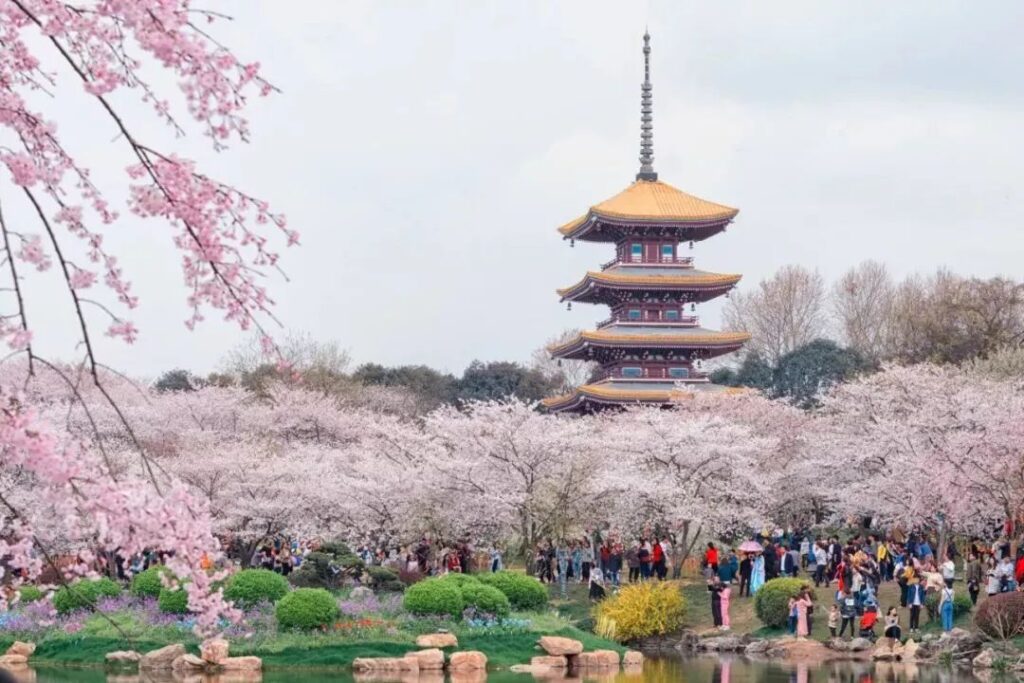
Walking here, you can recite poems with Qu Yuan by the “lakeside,” supervise battles with King Zhuang of Chu by beating drums, and take a look at the genuine Marquis Yi of Zeng Bells and King Goujian of Yue Sword. Only then can you say that the trip is not in vain.
Qingchuan Pavilion, known as the “First Tower of Chu Sky”
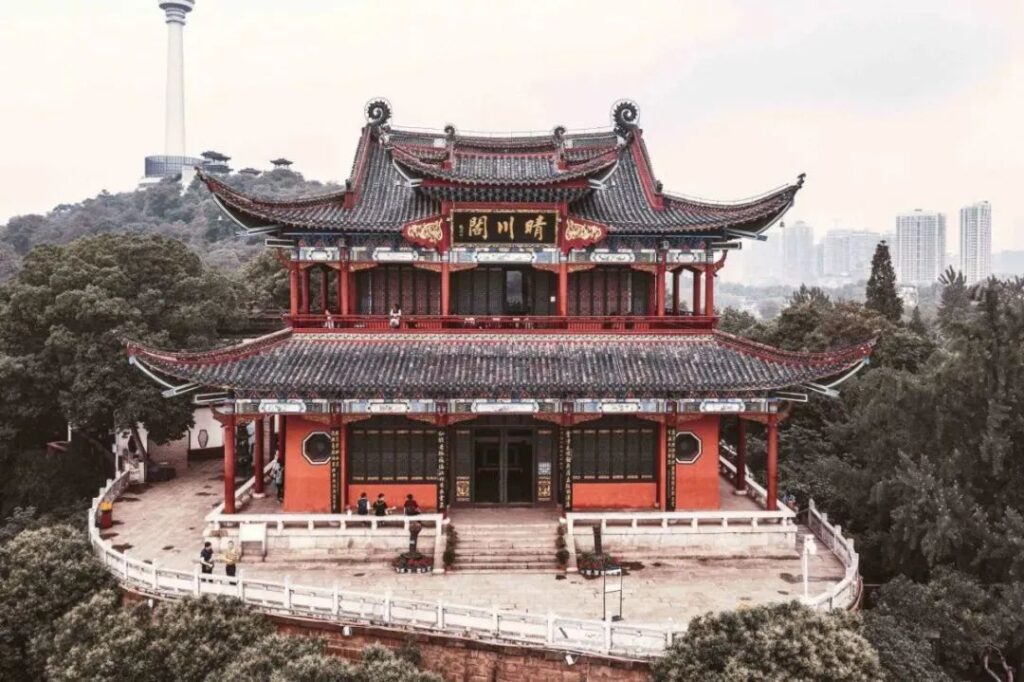
Bordering the Han River to the north and the Yangtze River to the east, Qingchuan Pavilion, as the only famous historical site in Wuhan that stands by the river, is known as the “First Tower of Chu Sky.”
Go see the slow-paced lifestyle street, Lihuangpi Road
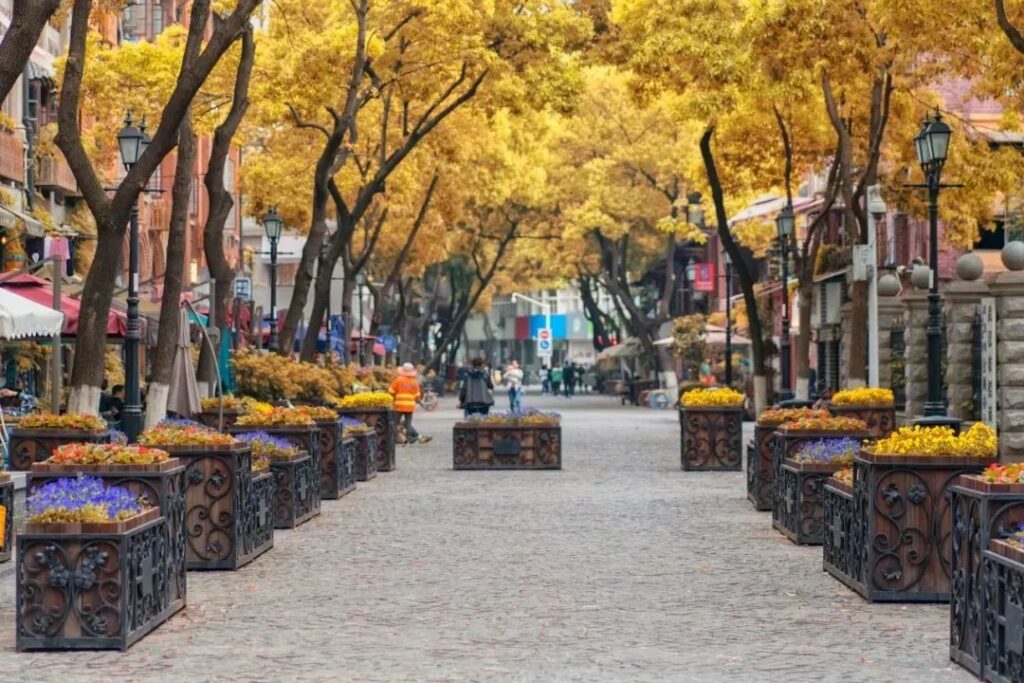
Lihuangpi Road has witnessed the architectural evolution of the old concession city of Hankou. As a famous “slow-paced lifestyle” block in Wuhan, it embodies the temperament and spirit of Hankou.
Go see Jiqing Street, which best represents Wuhan’s folk culture
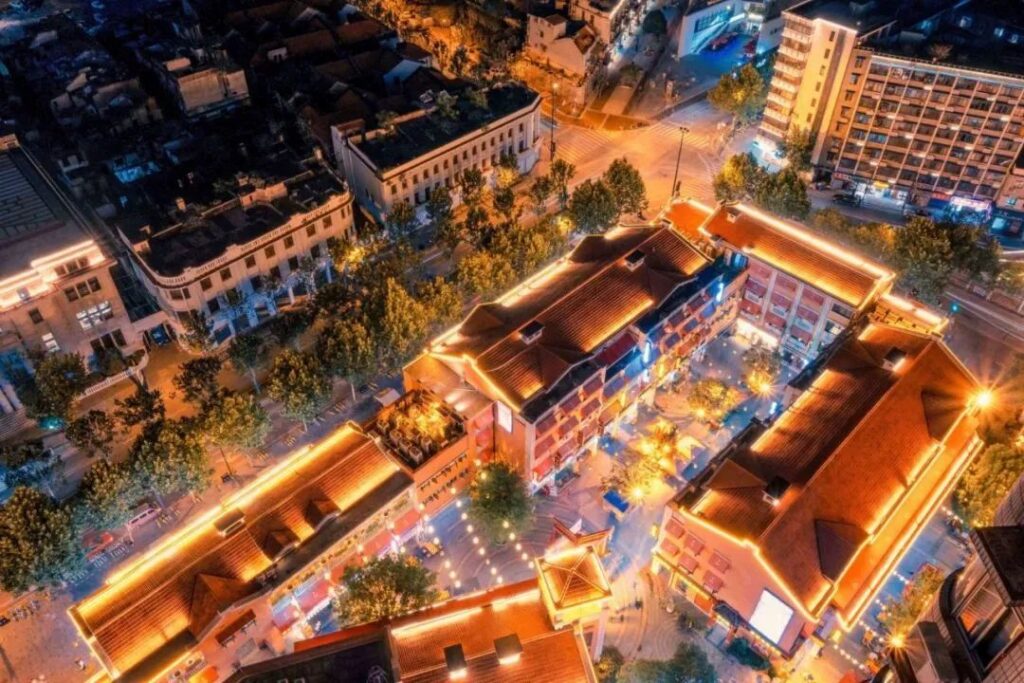
It’s not a long street, and it’s quiet during the day. However, when night falls, its charm can no longer be ignored. Flower sellers, violin players, diners… Even the bumpy road surface becomes lively and extraordinary.
Go see Hubu Alley, the paradise exclusive to foodies
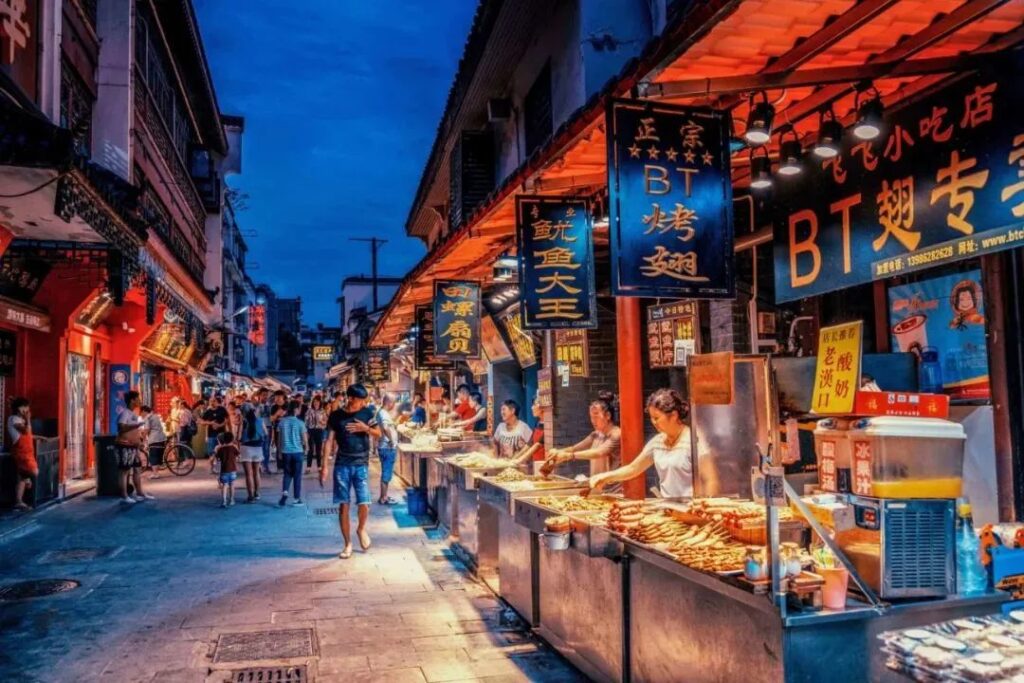
You don’t need to enter Hubu Alley to smell its wantonly spreading aroma from two streets away. Hot dry noodles, lotus root sandwiches, spring rolls, duck necks… You must fully savor all kinds of delicacies!
Go see the cherry blossoms in full bloom at Wuhan University
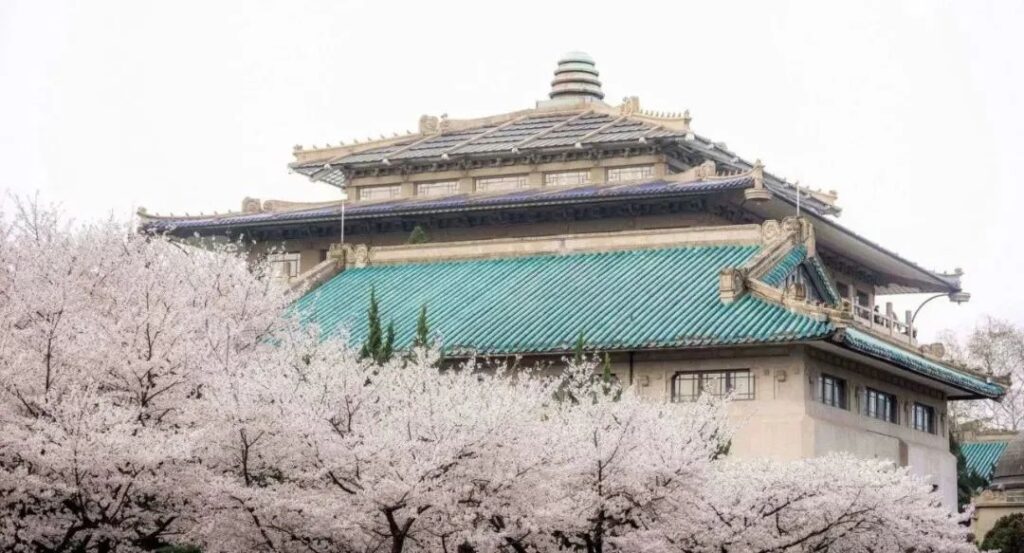
As a landmark building in Wuhan, Wuhan University is in full bloom with cherry blossoms in March, and the gorgeous pink color weaves a dreamy ocean.
Wuhan Food Guide
Wuhan is a city covered with delicious food. Wuhan snacks are very famous throughout the country and come in a wide variety. What is your favorite Wuhan food?
Hot dry noodles, the representative of Wuhan’s “breakfast”
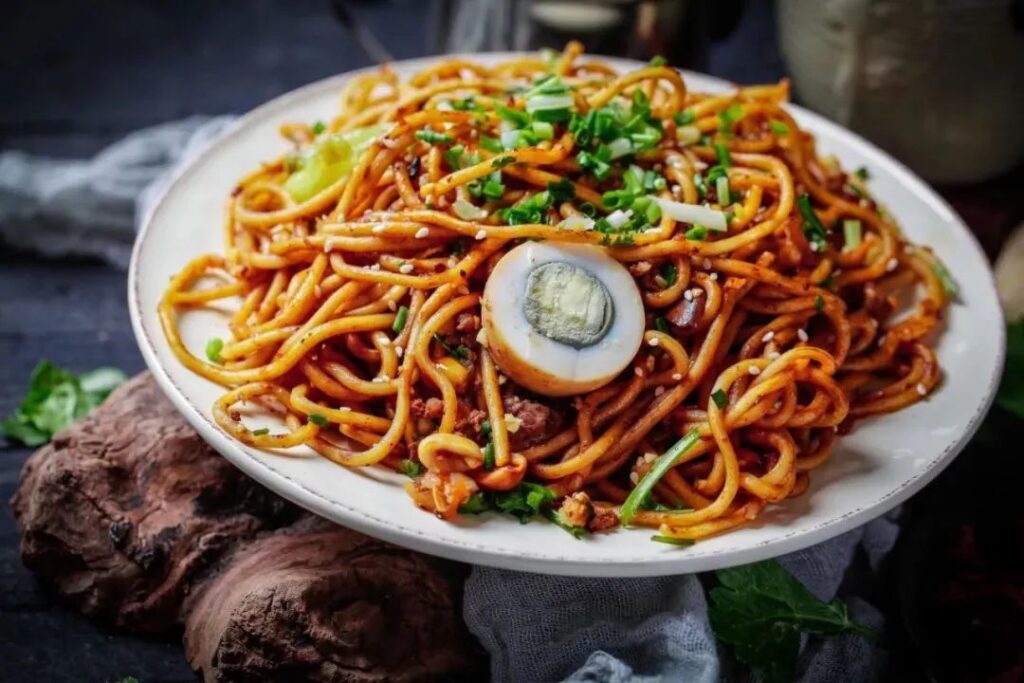
A bowl of hot dry noodles best reflects the “breakfast” culture of Wuhan locals. In the morning, when you pass by a stall and say, “Boss, give me a bowl of hot dry noodles, make it quick,” the boss will serve it from the bottom to your hands in no more than 1 minute. Eating while standing, sitting, squatting, or running has become the taste that many Wuhan locals miss.
Tofu skin without tofu
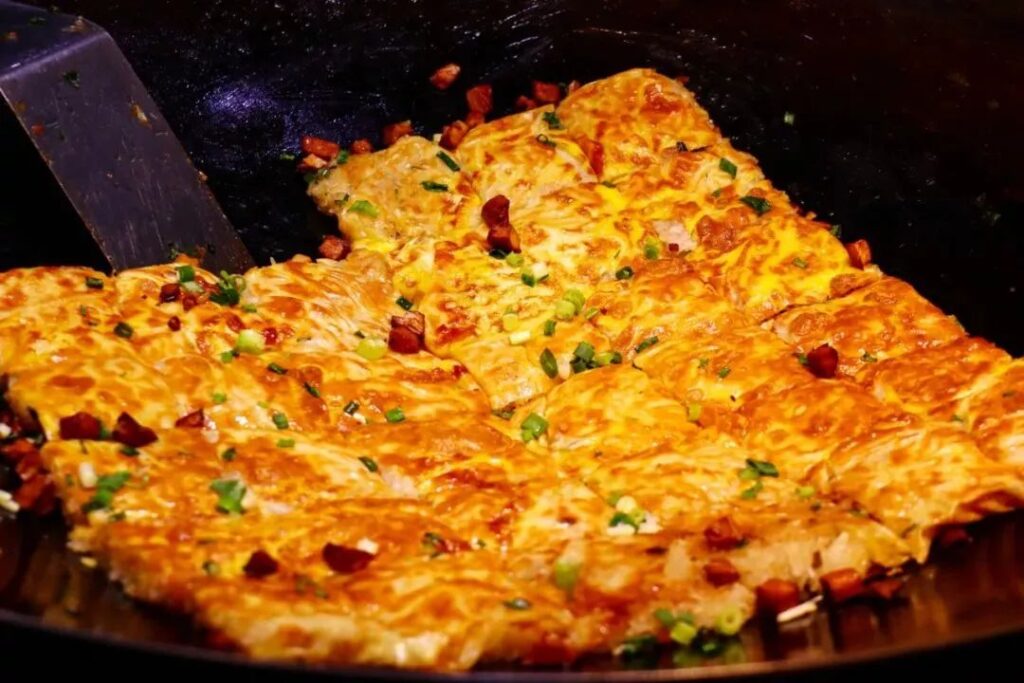
As one of the famous breakfast dishes in Wuhan, tofu skin can be talked about for three days and three nights without end. The tofu skin in the big black pot can be cut into 12 thin and square pieces, just the right size for one bite. The color is golden and yellow, and it is crispy and fragrant when you bite into it. The ingredients like green peas, mushrooms, and diced meat, paired with glutinous rice, provide a rich texture that you simply can’t stop eating.
The popular crayfish

Every city has its representative food, and for Wuhan, besides hot dry noodles, it’s crayfish. It’s a must-eat food in one’s lifetime, and Wuhan crayfish is one of them! From star-rated restaurants to street vendors, various crayfish stages showcase their skills, forming a stormy crayfish world.
Mianwo, the Wuhan “donut”
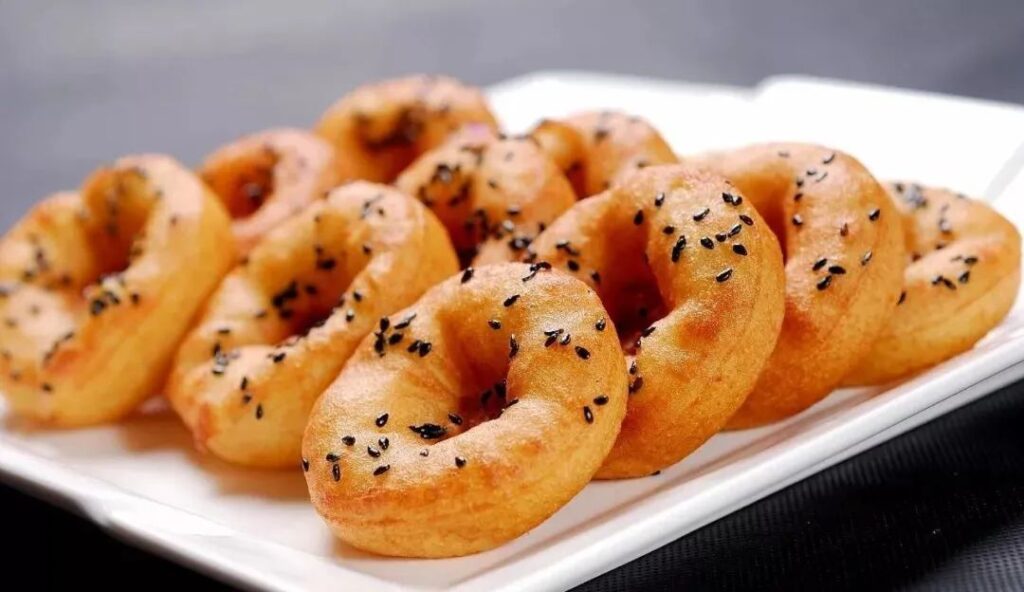
As the “top” of Wuhan’s “breakfast,” as long as there is a mianwo stall, there will be a circle of people waiting to eat. No matter how diverse Wuhan locals’ “breakfast” is, mianwo always has a place, after all, it’s what Hubei people have been eating since childhood. An excellent mianwo must be thin and crispy on the outside, soft and fluffy on the inside, and still have a lingering fragrance without being greasy. After eating one, you’ll want to eat more!
“Easily explosive” soda buns

Soda buns are not like the soft and chubby buns in the steamer. They are made by adding water and then pan-frying, a special bun forged through countless trials. The two most traditional flavors in old Wuhan are mushroom and glutinous rice buns, with a delicate texture of glutinous rice and mushrooms; and authentic taro filling, with a crispy outer skin and a soft and airy filling.
Rice cakes that resemble imagawayaki

On the streets of Wuhan, there are always people pushing big carts selling rice cakes. It is a very traditional Wuhan breakfast, and its shape looks more like an imagawayaki without filling. The rice is ground into rice paste, with a little wine starter and sugar added, and allowed to ferment naturally. After being baked in a hot pan, the outer skin of the rice cake is golden and tempting. Eat it while it’s hot, and with one bite, your mouth is filled with a crispy and fragrant taste, while the inner rice paste has a texture similar to rice cakes, sweet and soft.
Shaomai eaten with oil cakes

Shaomai is usually eaten with oil cakes. It is a beloved “breakfast” snack of Wuhan people, often found in inconspicuous shops. Every early morning, office workers, students, and housewives line up in queues that can take up half a street. Glutinous rice, meat, mushrooms… it tastes tender and fresh, with a strong pepper flavor as soon as you bite into it.
Duck neck, the C-position of Wuhan’s late-night snacks

Eating duck neck in Wuhan is all about solid friendship. During late-night snack time, sitting on the streets and alleys, chatting about family and work, you can feel the authentic atmosphere of the city. If a Wuhan local eats duck neck with you on the street, then congratulations, they already consider you one of their own. The spiciness of Wuhan duck neck has colorful answers. With salt and sauce added, there’s spicy, numbing, salty, and sweet spicy flavors, making both your heart and stomach well-behaved.
Intoxicating rice wine

The rice wine has egg flower and small round balls in it, and a big pot full of it is placed in front of you, just looking at it makes you drunk~ The rice wine is so gentle when it enters your mouth, with both the aroma of wine and a faint rice fragrance. Paired with the sticky glutinous rice balls, it’s intoxicating and filling, a favorite of many people.
Experience the Chu charm
Enter the Hubei Provincial Museum to experience the charm of the ancient Chu state.
The Hubei Provincial Museum is known as the temple of Jingchu culture, with a collection of more than 240,000 pieces (sets) of cultural relics, including 945 pieces (sets) of first-class cultural relics and 16 pieces (sets) of national treasures.
The museum’s four treasures are: the Yunxian human skull fossil, the Marquis Yi of Zeng bells, the King Goujian of Yue sword, and the Yuan blue and white four-love plum vase.



The Hubei Provincial Museum holds more than a dozen exhibitions, such as the “Chu Culture Exhibition” and the “Marquis Yi of Zeng Tomb,” introducing the long history and splendid culture of the Hubei region to visitors with its exquisite and rich exhibits, excellent display layout, strong cultural atmosphere, and pleasant viewing environment.





